[Editor’s Note: The below article was published in May 2019 — it has been updated with the entries for “Parasite” and “Titane” in May 2022.]
Who would have known when we made the below list of every Palme d’Or winner ranked that the next three years would see only two additions to the list? For the first time since 1968, when the festival, in solidarity with the May 68 movement, was last canceled, Cannes didn’t happen. The planned 2020 edition of the festival was one of the countless events postponed due to the pandemic. And though a selection was announced and laurel leaves allowed to be used in the marketing for those films, no Palme d’Or was awarded. (Other times the festival was canceled was in 1948 and ’50, due to budgetary problems, and of course during World War II.)
“Parasite” and “Titane” are two of the most critically acclaimed Palme winners in some time. Of course, annual awards hype tends to drive the perception that the Oscar is the highest award in the film community. But for countless filmmakers and cinephiles around the world, the Palme d’Or comes out ahead. Ever since 1955, the Cannes Film Festival has assembled a discerning jury of A-listers to bestow this honor on an exclusive Competition section featuring some of the greatest auteurs the medium has known.
Originally known as the Grand Prix, the shimmering Golden Palm has played a key role in advancing careers, but it has just as often fallen to veterans of the form, and across seven decades juries have acknowledged an astounding range of cinematic accomplishments. But some of these prizes were worthier than others.
Here’s a look at all the Palme winners over the years, ranked in order of which ones we believe deserved it the most. Viewed as a whole, the winners provide a complex survey of international cinema from the past three quarters of a century, and anyone unfamiliar with these titles should consider the following list as an essential viewing guide.
With contributions from Tom Brueggemann, Jude Dry, David Ehrlich, Tambay Obenson, Chris O’Falt, and Anne Thompson.

Michael Moore at Cannes
Laurent Rebours/AP/REX/Shutterstock
The accolades for Michael Moore’s 2004 documentary are extensive: a reportedly 20-minute long standing ovation at Cannes, the highest box office take ever for a doc, Moore’s first (and, so far, only) Palme d’Or win. And yet that doesn’t mean it’s impervious to criticism or that it’s even held up in the 15 years since it first arrived on the Croisette. Both slavish and slapdash, what once seemed urgent and unsettling now just plays like agitprop without much to anchor it. Zipping between the tragedy of 9/11, George W. Bush’s military record, and an extended metaphor about burning paper, it’s a film that shows off Moore’s tendency toward blunt metaphor, with seemingly no restraint. Moore himself has come back from the film with better, tighter, more refined work, including last year’s “Fahrenheit 11/9,” which serves as a bit of a course correction to its predecessor. —KE
The first film Palme recipient, and one of two documentary winners, Jacques Cousteau’s account of his ocean studies on the Calypso pioneered underwater color photography. Co-directed by Louis Malle (presaging his later documentaries), it remains a visually strong film even as its content now feels familiar. At the time, it was eye-opening for audiences. Columbia released it theatrically in the U.S., and it also won the Best Feature Documentary Oscar. Viewed today, however, it hasn’t aged well: The storytelling has a naive quality and the filmmaking suffers from a sometimes uncomfortable sense of environmental recklessness. —TB
Francois Truffaut was one of the jurors the year this obscure Brazilian religious fable won. It came the year after Bunuel’s heretical comedy “Viridiana” tied for the prize. This much more didactic tale, based on a play and top-heavy with dialogue (substantially filmed on the steps of a church where a peasant is attempting to make an offering). The conflict comes when the fearful clerical hierarchy fears his efforts are tainted by voodoo. This is about as a strange a Palme winner in history. It was an Oscar Foreign Language nominee, but even with the dual distinctions didn’t get released in the U.S., and then barely, until 1964. The same period saw the birth of of Brazil’s Cinema Nuovo, one of the most important national new waves of the ’60s. It remains the sole Brazilian winner, and the only one of Duarte’s films to have significant exposure abroad. —TB
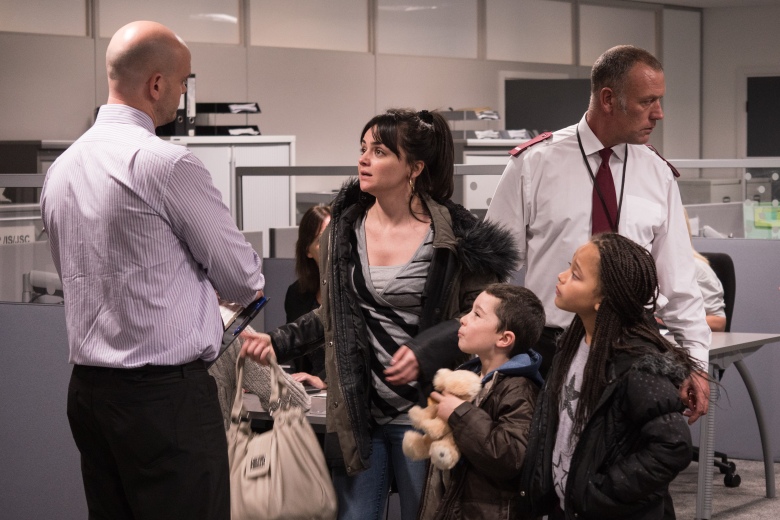
“I, Daniel Blake”
English director Ken Loach won his second Palme d’Or after “The Wind That Shakes the Barley” with his harrowing 2016 kitchen sink drama “I, Daniel Blake.” Told with Loach’s trademark matter-of-factness, the film focuses on the story of a 59-year-old heart attack survivor fighting to receive financial support from England’s welfare system. The subject matter is almost too bleak. Loach’s script sticks to an oppressive tone, offering little moments of levity or surprise for those willing to endure its punishing details. Only the two performances Loach gets out of Dave Johns and Haley Squires elevate the otherwise grim tone. Squires in particular delivers unforgettable work as a down-and-out single mother who befriends the title character. Loach’s script forces both actors to go through an emotional wringer, and it’s the way they come out the other side with humanity intact that makes “I, Daniel Blake” cross the finish line as an impactful drama, albeit one that can’t compete with the best of Cannes. —ZS
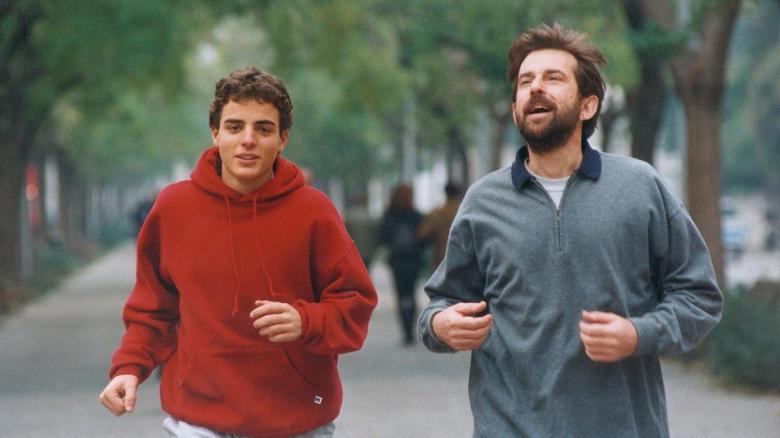
“The Son’s Room”
““The Son’s Room” might be worthy of a Palme d’Or, but it definitely wasn’t worthy of the Palme d’Or in 2001, when Nanni Moretti’s somber drama eked out a victory over a lineup of instant classics like “Mulholland Drive,” “Millennium Mambo,” and “The Man Who Wasn’t There” (and that’s just counting the Competition movies that started with the letter “M”). From that moment on, this aching little movie was doomed to an eternity of ranking towards the bottom of lists like this one. And that’s probably where it belongs.
Be that as it may, winning a prize it didn’t (at all) deserve is the worst sin that “The Son’s Room” commits. A feature-length Brian Eno commercial that’s cloaked in a tender, meditative portrait of a broken family trying to reassemble itself, Moretti’s film couldn’t be much simpler: The writer-director stars as a therapist whose life is warped by grief when his 17-year-old son drowns. Eventually, after much domestic strife and internal reflection, Giovanni and his wife (Laura Morante) come into contact with their late son’s girlfriend, and conscript her into helping them move on from their loss — a process that understandably involves listening to Eno’s “By this River” (maybe the most desolate song ever written) over and over and over again. “The Son’s Room” may not be the most innovative or ambitious film to premiere on the Croisette (in fact, it may be one of the least), but it understands the terrible thrums of grief, and compellingly grapples with the painful realization that losing someone means never getting them back. —DE
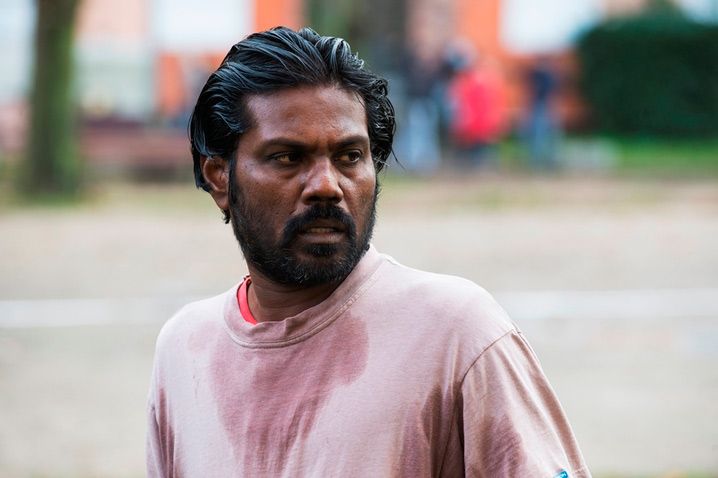
“Dheepan”
Seen by some as a career-achievement win for Jacques Audiard, who’d previously won two major awards at the festival (Best Screenplay for “A Self Made Hero” and Grand Prix for “A Prophet”), “Dheepan’s” victory wasn’t especially inspired. 2015 was also the year “Son of Saul,” “The Assassin,” “Carol,” and “The Lobster” premiered in Competition, and though none left the Croisette empty-handed, it was difficult even at the time not to feel like they’d been shortchanged. “Dheepan” certainly has its moments, from its striking title cards to Antonythasan Jesuthasan’s performance in the title role, but its violent, action-flick third act seems lifted from some other, lesser movie. —MN

British Director Ken Loach Poses with the Palme D’or Award He Won For His Film ‘The Wind That Shakes the Barley’
Christophe Karaba/EPA/REX/Shutterstock
The first and more deserving of Ken Loach’s two Palme d’Or winners, “The Wind That Shakes the Barley” still isn’t an all-timer. Cillian Murphy and Pádraic Delaney star as two brothers who join the IRA to fight for Irish independence in 1920, with Loach directing from a script by frequent collaborator Paul Laverty; like most of the filmmaker’s recent projects, this wartime drama is well-mounted but lacking the spirit that made the likes of “Kes” so compelling. That hasn’t prevented him from continuing to be a favorite at Cannes — he’s premiered a dozen films there and, in addition to these two Palmes, somehow won the Jury Prize for “The Angels’ Share” — and, even if “The Wind That Shakes the Barley” isn’t his finest hour, it’s hard to begrudge him the honor. —MN
Volker Schlöndorff’s “The Tin Drum” somehow managed to tie “Apocalypse Now” to win the film world’s greatest honor over “Days of Heaven” and “My Brilliant Career” (and you thought “Crash” beating “Brokeback Mountain” was a disgrace). Adapted from Günter Grass’ allegorical novel of the same name, Schlöndorff’s fable-esque epic tells the rambling story of a blond young boy named Oskar Matzerath (David Bennent), a Joffrey Baratheon-looking tyke who’s given a tin drum for his third birthday, and then vows never to grow old.
The year is 1927, the world is trying to restore some kind of rhythm between wars, and little Oskar has no interest in playing a role in whatever atrocities are about to come next; this insufferable little troublemaker — a stand-in for all the German people who dug their heads in the sand — just wants to bang on his drum and scream at the top of his lungs whenever he gets peevish (his shrill cries have the power to shatter glass). Bennent, who was 12 at the time of shooting, delivers a powerful, undiluted performance that gets under your skin and stays there for almost three hours, but the picaresque narrative fails to find a steady beat, and even its most unsettling episodes skitter along the surface of the ideas presented in Grass’ book. Oskar may never get old, but his movie does. —DE
Cannes loves few filmmakers like the Dardennes brothers, who joined the two-time Palme d’Or club with “The Child” in 2005. (They’d previously won it for 1999’s “Rosetta” and would go on to take home Best Screenplay for “Lorna’s Silence” and the Grand Prix for “The Kid with a Bike.”) Another example of their affinity for low-key realism focusing on the downtrodden, it follows a young, out-of-their-depth couple’s halfhearted attempts to eke out an existence after having a son — who, in his infinite wisdom, the father (frequent Dardenne collaborator Jérémie Renier) sells to a black-market adoption ring. Most of the cinematic siblings’ movies operate in this realm, but few are as moving — or as deserving of their Cannes laurels. —MN
Winner of the very first Palme d’Or, Delbert Mann’s “Marty” seems like too modest a thing to earn either of those awards, let alone both. The story of a butcher in the Bronx (Ernest Borgnine) who’s resigned himself to a life of bachelorhood — a shameful condition in those days — the film basically follows its self-loathing title character as he looks for a girl as “pathetic” as he is, and then tries not to let the one he finds (Betsy Blair) slip through his fingers.
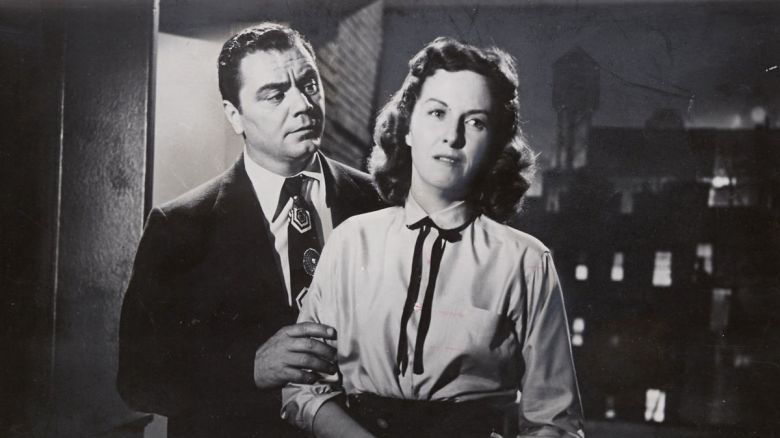
“Marty”
Told with the austerity of an Ozu drama and the stick-your-face-in-the-mud sadness of “Make Way for Tomorrow,” “Marty” is a lonely heart love story that feels a lot bigger than it seems on the surface, especially once the hero’s mom (Esther Minciotti) comes to the fore and you realize how little she’s got to keep things together. The characters in Paddy Chayefsky’s script are products of their time (one moment, in which Marty badgers his date for a goodnight kiss, might be particularly hard to swallow for modern viewers), but there’s a palpable timelessness to their yens and yearnings, and Marty’s climactic soliloquy conveys a universe of human desire in just a few short sentences. In other words, Mann’s film still has more to offer than just being a fateful answer in “Quiz Show.” —DE
In William Wyler’s 1956 drama based on the 1945 novel by Jessamyn West, the faith and pacifism of a peaceful Quaker family, led by Gary Cooper, is tested during the Civil War. Dorothy McGuire and Anthony Perkins round out the starring cast of a film about a family struggling to maintain its identity amid confusion and heartbreak at wartime. Triumphant performances, beautifully shot alongside a great score by Dimitri Tiomkin, bolster this warm and lovely story that shows that, when it comes to what’s at the heart of family, there really isn’t that great of a gulf between the present-day and 150 years ago. The film may not be the most adventurous cinematic achievement in the history of Palme d’Or winners, but it was nominated for six Academy Awards, including Best Picture, Best Director, and Best Actor in a Supporting Role. —TO
Sweden’s Bille August won the Palme d’Or twice. Ingmar Bergman never did for any one film, though he was awarded a special Palme as the best living director to never have won at the festival’s 50th anniversary. This three-hour feature film from an intended longer television miniseries (similar to Bergman’s own “Fanny and Alexander,” which exists in both versions) follows that film’s story of his childhood with a somewhat speculative look at his parents’ relationship. Based on Bergman’s script (he chose the director), his wife Pernilla (a previous Bergman star) took the Best Actress prize. Max von Sydow also starred. It received less than unanimous critical praise, certainly much less than “Fanny” or August’s own “Pelle.” Its American release saw it among the 10 top subtitled releases of 1992, but with only a fraction of what “Fanny” did as well below “Pelle.” August followed with an increasingly conventional series of prestige films (including “The House of the Spirits” and the 1998 non-musical “Les Miserables,” recently less seen outside of Sweden. —TB
61. “Pelle the Conquerer” (198
Swedish director Bille August co-wrote and directed this sweeping mid-19th-century epic, which bears some similarity to Jan Troell’s lauded ’70s hits “The Emigrants” and “The New Land,” also starring Max Von Sydow. This time, the Ingmar Bergman veteran stars as an impoverished older Swedish man who emigrates to Denmark promising his young son Pelle (Pelle Hvenegaard) a better life. Instead, they find servitude to a brutal farmer (Axel Strøbye), who houses his new workers in his chicken coop. After terrible mistreatment, Pelle adapts, learns Danish and finds his way, while his aging father Lasse finds love with a lonely woman whose missing husband, sadly, returns after years at sea. Scandinavia’s biggest-budget production ($4.5 million), co-produced by Denmark and Sweden and shot by cinematographer Jorgen Persson, won the 1988 Palme d’Or, critics’ raves, and the foreign-language Oscar for Denmark. “Pelle the Conqueror” was picked up for distribution around the world; thanks to an effective Miramax marketing push (it grossed $2 million in North America), Von Sydow scored his first Oscar nomination for Best Actor for his heart-tugging performance as a broken man who at film’s end, cannot face emigrating again himself, but sends his son toward America. —AT
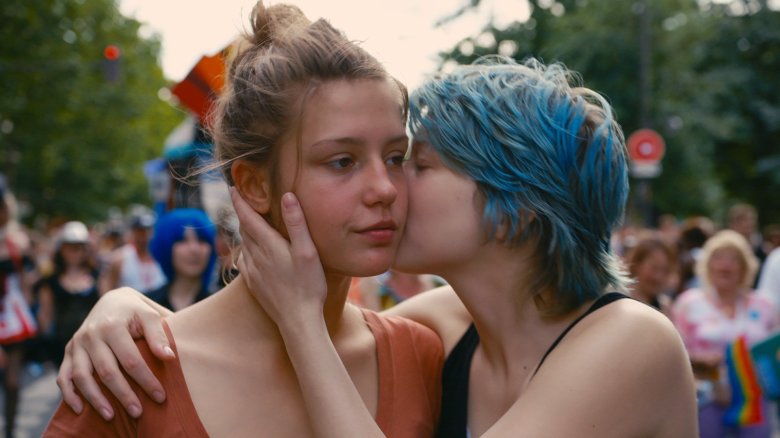
“Blue Is the Warmest Color”
The only film on this list to share the top accolade with its stars, Abdellatif Kechiche’s three-hour romance famously prompted walkouts at Cannes before winning the Palme d’Or — split three ways between the director and his two lead actresses. Based on a graphic novel, the film is a sexual coming-of-age tale about a young teacher named Adele (Adele Exarchopoulos), who finds herself immediately drawn to blue-haired lothario Emma (Lea Seydoux). The room stops when they lay eyes on one another in a crowded club, and they begin a lust-fueled affair that results in three epic sex scenes. While the excessive length (and acrobatics) of the bedroom scenes raised eyebrows, they’re surprisingly not as long as they feel. But it’s not only the sex scenes that are long: Kechiche’s commitment to realism extends to long shots of Adele eating spaghetti, teaching young children, and showering. Still, even with the controversy surrounding the film, we wouldn’t throw “Blue is the Warmest Color” out of bed. —KE
Two years after making a truly auspicious debut with “The Killing Fields,” Roland Joffé avoided the sophomore slump (and then some) by winning the Palme d’Or . Robert De Niro and Jeremy Irons helped him on that mission as a mercenary and Jesuit priest, respectively, in 18th century South America whose attempts to spread the good word are not exactly welcomed by their would-be hosts. (If that sounds at all similar to Martin Scorsese’s “Silence,” it is — and these two films would make quite the double feature.) Their quest isn’t easy, uplifting, or even successful, but it does serve as a reminder of how powerful matters of faith and spirituality can be when handled properly — something sorely lacking in most faith-based dramas of late. Through it all, they try to remember one key passage from the Bible: “The light shineth in the darkness, and the darkness hath not overcome it.” —MN
“Signore e Signori” was its Italian title, but the English one (used for its American release via Warner Bros.) conveys the tone of this three-part comedy of unrelated episodes. Omnibus Continental films were common in the ’50s and ’60s, but usually with a producer using multiple directors in a theme-related effort. In this case, director Pietro Germi, after “Divorce, Italian Style” and “Seduced and Abandoned” (he shared an Oscar for writing the former), this was a victory lap in a period when he was second only to Fellini among Italian directors in popularity in the U.S. The film, with tales of adultery, impotence, and an underage seductress, shared the Palme with Claude Lelouch’s “A Man and a Woman.” The two films — viewed half a century later — serve as prime examples of what appealed to domestic audiences about European cinema at that time. —TB
57. “The Class” (200
The rare “school film” that doesn’t cast its central teacher character as either a cock-eyed optimist or a rules-crazy disciplinarian , Laurent Cantent’s adaptation of François Bégaudeau’s (who also stars in the film) semi-autobiographical novel about his own experiences teaching is all about finding the shades between things (and people). Perhaps Cantent’s parents — both of them teachers — are to be thanked, or the cast of mostly non-actors, or Cantent’s free-wheeling, improv-heavy script. That neither Cantent or Bégaudeau were precious with the material is clear, and the result is a lived-in film that quietly reinvents the sub-genre (a French staple) by exploring it with realism and affection. The kids that round out the rest of the cast — actual teens, what an idea! — carve out unique spaces for themselves and, like their teacher, never give into convention or trope. That’s why Cantent is able to explore bigger questions with ease, striving to make a film about the differences that often render themselves obvious in an educational setting — from the intellectual to the economic — without hitting anyone over the head with them. Set over the course of a year, the occasionally meandering film tracks changing lives as the calendar ticks onward, and when school’s out for the summer, it’s hard not to feel a bit wistful for everything that has come before. —KE
A rare case of a year with co-winners that also would make a perfect repertory double feature. Both from Italy, both starring Gian Maria Volonte, both espousing leftist themes, they are a time capsule of a kind of early 1970s European cinema. Both came from prominent established directors – Petri, from a more mainstream/genre background, had just won the Foreign Language Oscar for “Investigation of a Citizen Above Suspicion,” and Rosi achieved prominence in the early 1960s for “Salvatore Giuliano.””The Mattei Affair” was a typical example of what “Giuliano” helped establish as a kind of biofilm. Either directly taking a historical figure or presenting a thinly veiled portrayal, it presented a figure fighting corruption (often in government, but business and the Mafia as well). “Z” just before, Alain Resnais’ “Stavisky” are other prime examples of what the BFI in its retrospective of Rosi’s films called “cine-investigation,” films that exposed crime and injustice, usually within the highest ranks of society. “Mattei” was about a government official who challenged the Italian oil oligarchy, then died in a mysterious plane crash with charges the British government plotted it.
It today ranks below Rosi’s top films, which along with “Giuliano” include “Hands Over the City,” then later “Christ Stopped at Eboli” and “Three Brothers.” It was released in the U.S. by Paramount (those were different times) to minimal impact. (Rosi’s next film, “Lucky Luciano” with Rod Steiger as the legend mob figure had a much wider release post “The Godfather.”) In any event, it was more prominent than the minimal release accorded to “Working Class” (U.S. title: “Lulu the Tool”) by the the recently formed and often political New Line Cinema. Lulu is a worker in a factory, loved by his bosses for his productivity and not rocking to boat. His co-workers dislike him. When he loses a finger in an accident, his life starts unraveling and he begins to become alienated from the world. This was the middle film in Petri’s so-called “trilogy of neurosis” (“Investigation” was the first). Here, not only the owners but also his fellow workers are targets of cynicism, with the focus on a sympathetic male character who has lost his bearings (the film feels like a template for the somewhat less political Lina Wertmueller’s series of films shortly after with Giancarlo Giannini). Both “Mattei” and “Working Class” feel like time capsules of a past era, with a particularly strong local appeal (both were major hits in Italy) — they’re political, edgy, angry, and reminiscent of a kind of cinema that flourished briefly but lacked a quality of timelessness. —TB
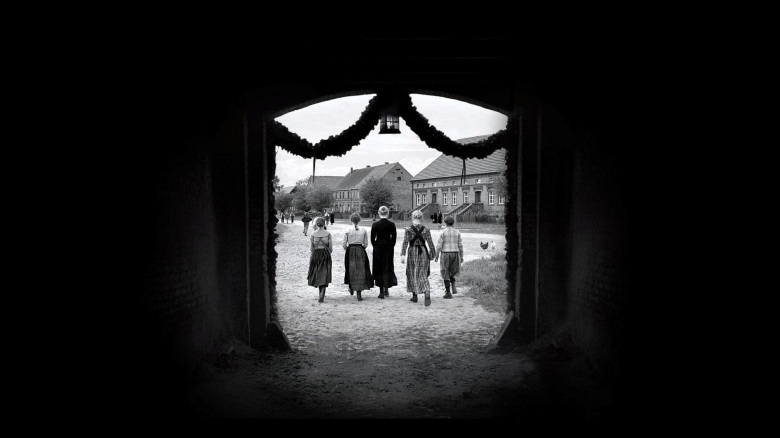
“The White Ribbon”
Michael Haneke likes to push his audience’s buttons, and he certainly did so once again with this black-and-white period drama that’s subtextually about the rise of Nazism. Set on the eve of Archduke Ferdinand’s assassination in 1914 in the small northern German town of Eichwald, “The White Ribbon” follows several different families who don’t realize their existence is about to be shattered forever. Much of the movie is about the children, presented as Bösekinder cousins of the inhuman tykes in “Village of the Damned.” The implication? This is the Nazi generation in proto form; they’ll grow up and steer all the horrors that follow. The Cannes Competition jury found that reading of fascism’s origins profound. Whether it really is is debatable; what’s not debatable is that the film’s cinematography is extraordinarily atmospheric, like a latter day exercise in German expressionism, ominous shadows cast from wind-whipped leaves and all. Dread pours out of every frame, making Haneke’s film a visceral experience, even if one wishes it was as stimulating to the intellect as well. —CB
For a moment, when Chen Kaige made a sumptuous epic that beat out the likes of “Naked” and “The Puppetmaster” for the Palme d’Or in 1993, it seemed like he would emerge as the defining voice of the so-called “fifth generation” of Chinese filmmakers. Alas, it was not meant to be; Chen’s follow-up, “Temptress Moon,” was befouled by production trouble and censorship issues, and he’s yet to fully recover. But even if Chen had managed to expand upon the critical and commercial success he enjoyed with his epic backstage portrait of the Peking Opera, “Farewell My Concubine” would likely still be remembered as the crown jewel atop his career.
As with many fifth generation films, “Farewell My Concubine” is framed by the upheaval of the Cultural Revolution, but Chen’s masterpiece stands apart for the magnificence of its scale, the melodrama of its story, and the meaning of its songs. Spanning more than 50 years, the movie follows two characters from boyhood to death, as they’re assigned to specific roles in an ancient tradition and forced to maintain their parts even as the world transforms around them (Leslie Cheung and Zhang Fengyi play the protagonists as adults, while the great Gong Li appears as the tragic courtesan who comes between them, albeit not in the way you might expect). A sumptuous and engrossing testament to the fact that political tumult is the sum of a billion personal histories, “Farewell My Concubine” was hacked down by Harvey Weinstein for its American release, but the full 171-minute cut — in dire need of restoration — flies by in a heartrending flash. —DE
Japanese master Shohei Imamura shared the Palme with Abbas Kiarostami’s “Taste of Cherry” for this tense drama about second chances. The story revolves around Takuro (Koji Yakusho), a man imprisoned for killing his unfaithful wife and forced to rebuild his life after being released from prison. After opening a barber shop, he forces a bond with the despondent Keiko (Miss Shimizu) and eventually gets dragged into her relationship dramas with a local loan shark. Imamura was already a major figure of the Japanese New Wave when he delivers this absorbing embodiment of the anger and vulnerability simmering beneath the surface of his country’s modern identity, and it’s an ideal introduction to his work — intimate, riddled with moral ambiguity, and grim to a fault, it also manages to hit a poignance note about the desire to keep going even when the prospects look bleak. —EK
Director Jerry Schatzberg shared the 1973 Palme with “The Hireling” for this classic embodiment of the greatest decade for studio-produced American cinema. The ambling drama finds two wayward men (Al Pacino and Gene Hackman at the height of their cinematic appeal) joining forces to start a business as they make an ill-fated journey to reconnect with old relatives who have moved on without them. In the process, they wind up in prison (for Hackman’s character, a second time) and attempt to set their lives back on track once more, with mixed results. But these efforts are mainly a springboard for the first truly modern buddy movie, as the pair develop a unique co-dependency that their other relationships in life could never provide. With the one-two punch of 1971’s “Panic in Needle Park” and this gripping seriocomic character study, Schatzberg proved he was one of the most impressive American directors to emerge in this revered decade — and remains one of the least appreciated. —EK
Emir Kusturica, a Serbian Yugloslav, had made only one feature before this was the surprise 1985 winner. It is the first of his two Palme recipients (“Underground” in 1995 is considered his masterpiece). Though not autobiographical, it does autobiographical shadings in its recreation of early ’50s Yugoslavia, and how its complicated politics (including the break from Moscow) affected the life of a six-year-old boy. He is told his father, actually a political prisoner, is traveling for work. This lengthy story includes a rich array of oversized characters, an earthy appreciation of their struggles, and ability to cope (similar to earlier Czech New Wave films; Kusturica studied film in Prague), and a passionate love of his complicated country shortly before the end of Communism and its descent into civil war. Key to its success is the sensibility conveyed from the point of view of a little boy. Kusturica himself often acts and is also a musical performer. His experience in both fields gives extra color to this film. —TB
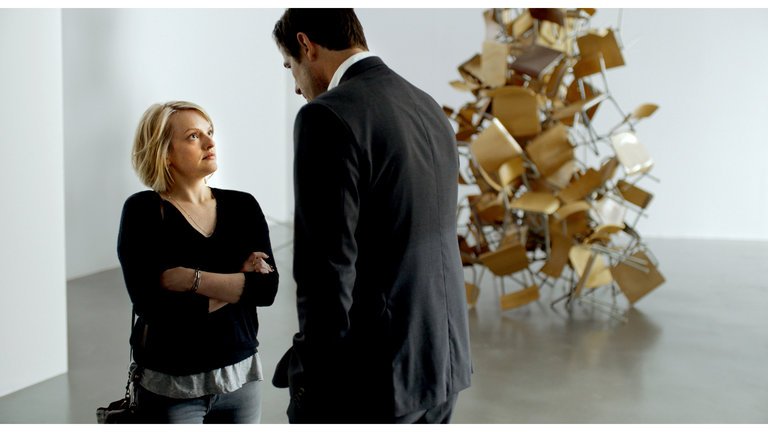
“The Square”
Three years after debuting his uproarious black comedy “Force Majeure” at the festival, Swedish filmmaker Ruben Östlund returned with a new take on yet another institution in need of a righteous skewering. While “Force Majeure” took on the family unit and the concept of masculinity, “The Square” went after the staid art world and even offered some unique perspectives on modern femininity in the process. Mostly a send-up of the contemporary art market and the viral spread of social media, “The Square” pads out its outrageous humor with some sneaky-good performances, from Claes Bang to Elisabeth Moss. Still, it’s Terry Notary’s full-throttle performance art piece that really drives the film. He’s cast here as Oleg, a man who acts like an ape and manages to get his audience — both in the film and out in the theater — to feel a terrifying spectrum of emotions. That’s what art — even at its silliest extremes — is for, and that’s where Östlund continues to find his own nutty ways to excel. —KE
Gillo Pontecorvo’s “The Battle of Algiers,” a masterpiece told from an outsider’s perspective about that country’s war of independence from France, paints the struggle in an urban setting. “Chronicle of the Years of Fire” was made by an Algerian, from the Arab point of view, about the 15 years before actual war broke out in 1954. This three-hour long film is knowing and intimate in its portrayal of its characters and a good historical introduction to the subject, but it lacks the cinematic scope achieved by Egypt’s Yuossef Chahine, the master of Sarahan African cinema. The film was met by death threats when shown at Cannes, with anger among the the pieds-noirs — the European citizens of Algeria when it was a French province — still simmering. It never received a conventional U.S. theatrical release, and remains little known here to this day. —TB
Belgian auteur siblings Jean-Pierre and Luc Dardenne won their first of two Palme d’Ors for this seminal work of social realism, the genre they do better than anyone these days. The story of the titular young teen (Émilie Dequenne, who won best actress at the festival) struggling through life at a trailer park with her alcoholic mother is a distillation of the Dardennes’ ability to craft absorbing depictions of lower-class life through striking personalities and slow-burn suspense. Rosetta’s quest to get a job at a local waffle shop, even at the expense of the kind-hearted man who works there, builds to a series of unnerving incidents in which the story threatens to devolve into a gimmicky crime saga. But the Dardennes are smarter than that, and keep the audience hooked by hinting at the possibility of Rosetta’s frustrations over surroundings to yield terrible circumstances even as they keep the drama rooted in her psychological uncertainty. The ambiguous finale isn’t quite a happy ending, but it manages to convey the vanity of trying to fix a broken system — really, nothing Rosetta does can change her situation — while hinting at the prospects of surviving another day through companionship. The film shows just how much the Dardennes were able to craft their own version of neorealism based on around contemporary Belgian concerns. Above all else, “Rosetta” illustrates the Dardennes’ penchant for merging dour social commentary with first-rate suspense. It’s a riveting drama from filmmakers who excel at transforming mopey naturalism into intense visceral experiences. —EK
Two years after Joseph Losey’s “The Go Between” won at Cannes, a second adaptation of a novel about illicit love set among the English countryside aristocracy shared top honors (with “The Scarecrow”). Directed by Alan Bridges, previously known for directing plays shown on BBC, this one starred Robert Shaw as a chauffeur who becomes involved with Sarah Miles as his wealthy employer. It’s no “Driving Miss Daisy,” but instead more of a critical study of how perspectives skewed by class differences can lead to damage and hurt. This had much less impact than Losey’s earlier film, though both received a domestic release through Columbia. Bridges continued mostly with TV work, although his later “The Return of the Soldier” and “The Shooting Party” received modest attention the following decade. —TB
Richard Lester’s follow-up to Beatles classic “A Hard Day’s Night” is another kinetic, slapstick valentine to the swinging ’60s. This black-and-white comedy of romantic manners adapted by Lester and Charles Wood from the Ann Jellicoe play deploys a chorus of colorful older Londoners to comment on the sexual mores of the young, embodied by hipster drummer Tolen (Ray Brooks). He has “the knack” of landing girls, while less smooth and practiced schoolteacher Colin (Michael Crawford) does not. In order to learn from the master, Colin moves in with Tolen to observe his seduction techniques firsthand. As he is acquiring a bigger four-poster, he meets Nancy, a shy, smiling gamine from the country searching for the YWCA (Rita Tushingham), who helps him carry the bed back to the bachelor pad, where Colin does not want to share her with his pal. Misunderstandings ensue when Nancy faints and thinks she has been raped by Tolen. Lester not only has his actors address the camera, but uses disjunctive editing techniques, funny subtitles, and a jazzy John Barry score. (Jane Birkin, Charlotte Rampling, and Jacqueline Bisset all launched long careers with this film.) The movie scored six BAFTA nominations after its surprise Palme d’or win at Cannes. —AT
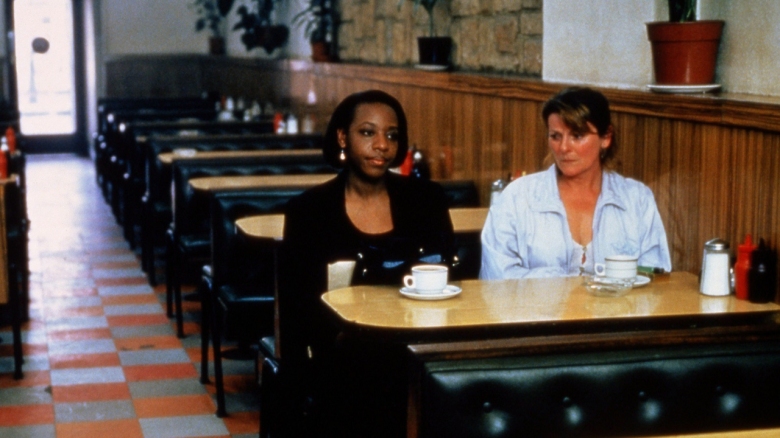
“Secrets & Lies”
Mike Leigh’s tangled family drama classic stars Marianne Jean-Baptiste as a young black optometrist who, after the death of her adoptive parents, decides to track down her biological mother, whom she discovers is a white woman (Brenda Blethyn). The chaos that is the family life of the mother provides much fodder for drama. As with every Mike Leigh work, the acting is first-rate, thanks in large part to the filmmaker’s methods – he workshopped the script during several lengthy rehearsal periods with the cast that lasted months. The results include some very believable performances, since the actors helped create the characters. And cinematographer Dick Pope’s unceremonious photography underscores the film’s docu-drama aesthetic. Marianne Jean-Baptiste received an Academy Award nomination for Best Supporting Actress, making her the first black British actress to be nominated for an Academy Award. —TO
From director Claude Lelouch comes this 1966 classic — a tender, visually stirring film of rejuvenating love between a widow and a widower: a race-car driver (Jean-Louis Trinignant) and a movie script girl (Anouk Aimee) share a candid romance, while balancing the demands of career and parenthood. It’s a touching, realistic look at a burgeoning adult romance, with each participant encumbered by a past tragedy, causing them to proceed delicately. The film is also famous for Francis Lai’s gorgeous, swooning score. Winner of Oscars for Best Foreign Language Film and Best Original Screenplay, it’s quite possibly one of the sweetest love stories ever captured on screen. An inferior sequel, “A Man and a Woman: 20 Years Later” was released in 1986, and Lelouch plans to complete what will effectively be a trilogy, with a third film premiering at Cannes 2019. —TO
Somewhat ironically given the movement’s impact in France, no French New Wave director ever won the Palme d’or. Despite the movement being at its height by 1961, a debut film by Henri Colpi, also French, shared the prize (with Bunuel’s “Viridiana”), whose film was not a part of the movement. Colpi was an editor (he cut Resnais’ “Hiroshima, mon amour,” and continued in the craft at times for the rest of his career). Despite this initial win, he and this film remain little known, at least outside of France. Seen today, it feels like a film more from the “Tradition of Quality” in French film that Truffaut famously denounced in 1954. Alida Valli has run a suburban Paris bistro alone since her husband failed to return from a World War II POW camp. An amnesiac tramp who resembles him appears, with his true identity unclear. The film is reminiscent of French dramas from the ’30s and ’40s, from directors like Carne, Pagnol, Duvivier, and others who represented more conventional craft and narrative and less personal style. (Bosley Crowther’s favorable New York Times review starts by praising it being different from recent French films.) Separated from its context, this is an involving story plenty of pleasurable moments to spare. —TB
42. “The Tree of Wooden Clogs” (197
“The Tree of Wooden Clogs” is a triumph of naturalism like almost nothing else in cinema, and it feels like the end-state of Italian Neorealism – that after Ermanno Olmi’s epic there simply isn’t any further to go in the form. Olmi tells this three-hour story of four families living and working on a massive communal farm in Bergamo, Italy, at the turn of the 20th Century. It’s brought to life entirely by local non-actors speaking in the Bergamasque dialect. Most of the film is just vignettes of farm life: characters singing while shucking corn, attending mass, dealing with the fallout of sending a son to school instead of having him work, going through the elaborate process of slaughtering a pig (animals were harmed in the making of this film). No wonder it’s one of Mike Leigh’s favorite films, and on the Criterion Blu-Ray of “The Tree of Wooden Clogs” he opines about how much is added by having non-actors familiar with farm life do things they’re familiar with. (Leigh jokes about how silly the idea of “city thesps” learning to slaughter a pig would be.) The life of the farm workers is contrasted with that of the wealthy landowners for whom they are devoting the vast portion of their labor in a kind of a modern feudalism. Olmi finds grace in their toil and sets scenes of their work to Bach, while the landowners’ children play frilly Mozart rondos on their clavichord. Talk about getting political through subtext. —CB
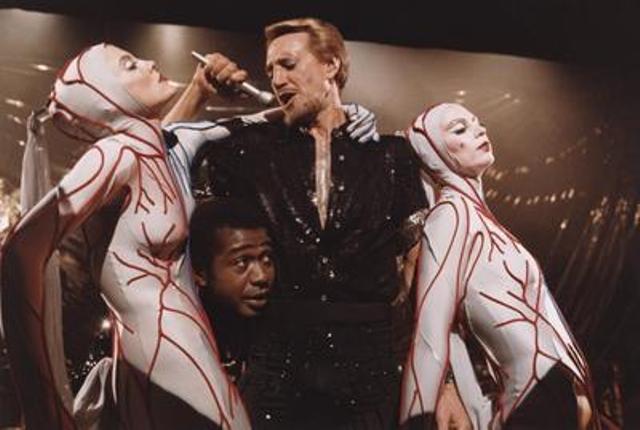
“All That Jazz”
How sad that F/X butchered Bob Fosse’s life story in a miniseries when he himself laid it all out so gracefully almost 40 years ago. One of the great original movie musicals the likes of which we rarely see, the film loosely mirrors Federico Fellini’s “8 1/2” in its loosely autobiographical, lightly fantastical tale of an egomaniacal artist and the women who orbit him. The film features a feverishly charismatic performance from Roy Scheider as Fosse stand-in Joe Gideon, as well as turns from legends in their own rights Jessica Lange and Ann Reinking. Fosse’s singular style and distinctive choreography were always going to look great on film, but the fact that he wrote (with David Alan King) and directed such a painfully intimate mortality play is no small feat. —JD
It’s still hard to imagine what it must have felt like to watch Robert Altman’s irreverent, unconventional comedy-war film while the country was steeped in the destruction of Vietnam. In parts it was a comedy as black as “Dr. Strangelove,” but with an apolitical absurdity that is almost more dangerous. The episodic film was filled with comedic sequences, like when a character, Painless, decides to commit suicide over a bout of impotence. The MASH crew stages a Last Supper to administer the fatal pill – complete with the song “Suicide is Painless,” that would become the hit spin-off TV show’s theme – which is nothing more than an elaborate scheme to get him laid. Robert Altman’s experimental use of long takes packed with characters who are all individually mic’d and carrying on various conversations felt like a radical departure for a studio-released comedy. The surprise Palme d’Or winner would go on to become an even bigger surprise hit and cultural phenomenon. —CO

“Elephant”
One of the most haunting films to win the Palme d’Or, Gus Van Sant’s “Elephant” takes inspiration from the Columbine High School massacre to create a portrait of America sleepwalking its way towards tragedy. Van Sant’s script consists of minimal dialogue, with the actors improvising much of their hallway banter. The effect gives “Elephant” the feel of a documentary, with Harris Savides’ gliding camera creating a level of senselessness that only increases in claustrophobic intensity once the shootings begin. “Elephant,” which took home the Palme d’Or in 2003, is an unrelenting story of American tragedy that most Americans don’t want to accept, so it’s no wonder the movie hardly made a similar impact stateside as it did at Cannes. —ZS
For a while there, no one was making political thrillers quite like those of Costa-Gavras. After winning the Jury Prize for 1969’s “Z,” he returned 13 years later with “Missing” to win the big one. In one of his best (and least funny) performances, Jack Lemmon plays Edmund Horman, whose son Charles was disappeared (read: murdered) during Chile’s 1973 coup d’état. Lemmon is joined by Sissy Spacek as Horman’s daughter-in-law, with the film taking on an increasingly hopeless, almost claustrophobic mood the longer it goes on. That’s thanks in part to a characteristically dense score from Vangelis, to say nothing of the true story on which “Missing” is based, and Costa-Gavras condemns everyone involved in the travesty without ever mentioning them by name. For his efforts, he won not only the Palme d’Or but shared an Academy Award for the film’s script with co-writer Donald E. Stewart; despite being celebrated elsewhere, the film was banned in Chile. —MN
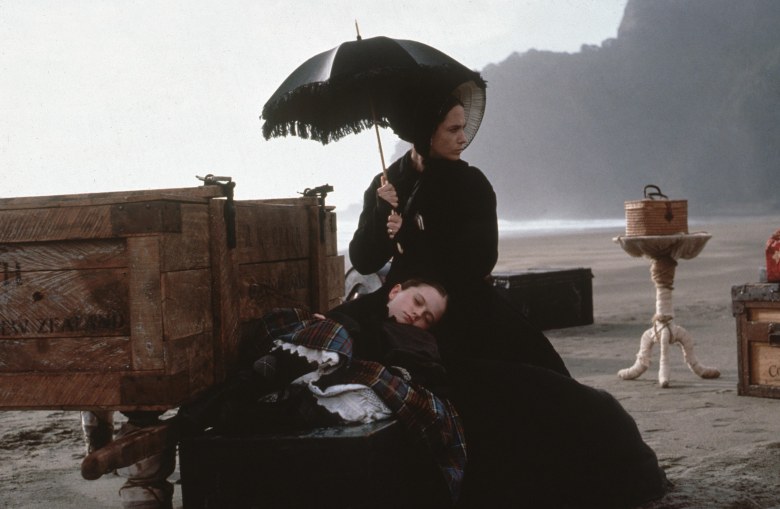
“The Piano”
Jan Chapman Prods/Miramax/Kobal/REX/Shutterstock
At the debut Cannes Palais press screening of Jane Campion’s 1850s romantic drama, critics wept at the story of a lonely, unhappily married mute pianist (Oscar-winner Holly Hunter) who prefers a rough but tender New Zealand pioneer (Harvey Keitel) to her taciturn husband (Sam Neill). Twenty-three years later, standing alone as the only woman director in a sea of male Palme d’Or winners, Campion was cheered at the Cannes 70th anniversary celebration. No other woman has taken home that prize. And Campion is one of five women to be nominated for the Best Director Oscar; she took home the win (for Original Screenplay) along with Hunter for her emotional silent performance and Anna Paquin as her watchful young daughter. This inimitable and intimate movie holds up over time and still delivers an emotional punch. —AT
The year after Cannes was cancelled on account of student protests, it was only natural that the Palme d’Or should be awarded to a film about a bloody insurrection on the grounds of a campus. A furious drama that dares to consider the upside of revolutionary violence (and ends with a righteously justified school shooting in which students begin opening fire on their parents and teachers), the movie is called “If…,” as in “if… anyone made this today, it would ruin the careers of literally every single person involved.”
But Lindsay Anderson was never afraid of sending a warning shot across the bow of Britain’s establishment culture, and neither was star Malcolm McDowell, whose performance as sixth form non-conformist Mick Travis — a character he would reprise in “O Lucky Man!” and “Britannia Hospital — serves as a feature-length audition for the role he would play in “A Clockwork Orange” three years later. In a Cannes year that also contained the likes of “Easy Rider” and “Z,” “If…” was far from the only film to hurl a grenade at the status quo, but Anderson’s vision is so unblinking and incendiary that it stands apart. It’s rare that a movie conveys a direct threat from one generation to another, and “If” resonates as an unshakeable relic of a time when pop art wasn’t afraid to stage a direct assault on the powers that be. —DE
35. “Eternity and a Day” (199
Greek auteur Theo Angelopoulos was long overdue for a Palme d’Or before he won in 1998, emerging triumphant from a rather paltry Competition lineup that was highlighted by the likes of “The Hole,” “The Idiots,” and “Velvet Goldmine” (alas, Roland Emmerich’s “Godzilla” screened Out of Competition). But if “Eternity and a Day” isn’t quite the equal of earlier masterpieces like “The Travelling Players” and “The Suspended Step of the Stork,” Angelopoulos’ poetic meditation on death and meaning is still the touching work of an uncommonly thoughtful film artist; an elegant, meandering walk through the fog of memory that traverses some of the director’s most haunting imagery before landing on a final shot that splits the difference between profound truth and saccharine nonsense.
The late, great Bruno Ganz (dubbed over in Greek) plays a dying Thessaloniki writer named Alexandros, whose final days take a sudden detour when he gets mixed up with a young Albanian boy who’s being trafficked through the country. That plot strand is knotted together with the wistful lamentations of an old man trying to take the measure of his own life, and the whole thing takes a while to wend its way towards the end (it turns out that eternity and a day is a pretty long time). If the somnambulant pacing and spiritual flourishes recall the last works of Andrei Tarkovsky, the moral imperative of the movie’s “plot” riffs on Akira Kurosawa’s “Ikiru,” another story about someone who searches for purpose as they shuffle off this mortal coil. But like any great film on the subject, Angelopoulos’ winner will leave you looking for your own. —DE
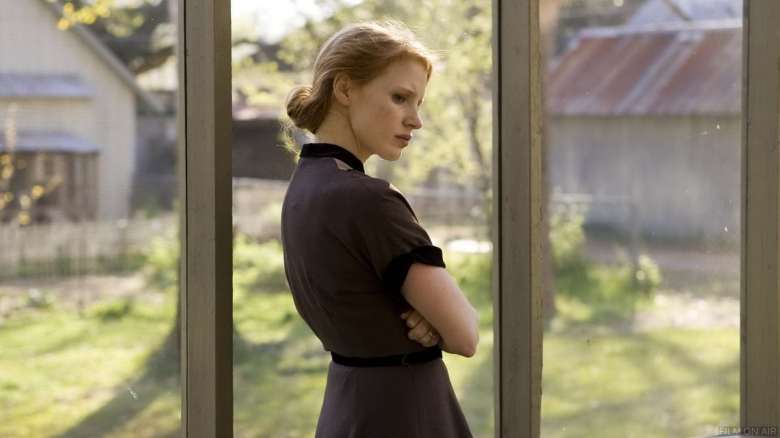
“The Tree of Life”
A visual poem told with light. There is always an element of spirituality to Terrence Malick’s work, along with an awareness that human existence is a spec of dusk in the vast span of the universe. It’s a theme blatantly explored in this film – including cutaways to scenes involving the creation of the universe – but it’s best expressed in the ephemeral moments Malick stages and finds, while cinematographer Emmanuel Lubezki chases the light, to create a portrait of a family in an endless struggle between life and death, light and dark, destruction and grace. “The Tree of Life” presents a cosmic vision of life, the universe, and everything: Few filmmakers would have the gall to cut from dinosaurs and the big bang to small town Texas life. But that uncompromising vision is what makes “The Tree of Life” such an unshakable experience. Some critics booed the movie at Cannes, but that didn’t stop the jury from awarding it with the highest honor. —CO
It’s not a perfect film, but if there’s any on this list that deserves to be better seen it’s Yılmaz Güney’s “Yol.” The story of its making is worth it alone. Güney was a political dissident who throughout the 1960s helped raise the profile of Turkish cinema like no filmmaker before him – his 1970 film “Umut” (“Hope”) even won acclaim from Elia Kazan. But he was jailed throughout most of the 1970s, first after being accused of harboring student radicals and then for allegedly shooting and killing a public prosecutor. He continued to write screenplays throughout his imprisonment, having his collaborator Serif Goren do the actual work of directing. In 1981, he escaped from prison and fled to exile in Paris – again, he had Goren do the work of actually directing “Yol.” This film is a triptych story of three prisoners in Turkey let out on a week-long furlough. One storyline follows a convict’s reunion with his wife — he was imprisoned for a heist-gone-wrong that resulted in her brother’s death, and her family wants him dead now for allowing that to happen. Another focuses on a Kurdish convict who journeys back to his family and sees the horrible oppression they face at the hands of the Turkish military — “Yol” was banned in Turkey just for including “Kurdistan” as an on-screen location title. And the last and most powerful is about the third prisoner, who upon being released from prison is confronted by his family with the fact that his wife committed adultery while he was locked up: they demand he journey with her back to her ancestral village for him to commit the “honor killing” of her. He doesn’t want to, but feels he has no other choice. What happens is unforgettable. —CB
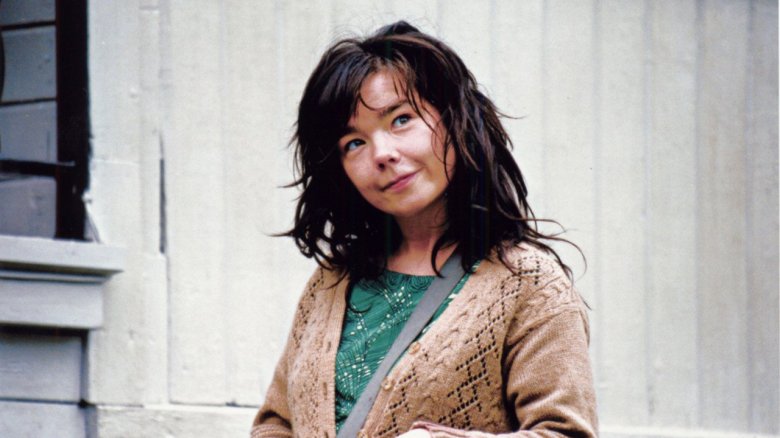
“Dancer in the Dark”
Director Lars von Trier’s provocative 1964-set drama-musical stars Björk as Selma, a Czech immigrant who works at a rural factory in Washington state, and is a single mother losing her eyesight from a hereditary disease. To protect her 10-year-old son from the same fate, Selma diligently saves her earnings to pay for a necessary operation. At night, she escapes into a world where “nothing dreadful ever happens,” rehearsing a production of “The Sound of Music” with best friend Kathy (Catherine Deneuve). But when a neighbor (David Morse) betrays her trust, Selma’s life unravels, and the lines between reality and fantasy blur. Peter Stormare and Joel Grey also star in this original tragic fairytale. It’s the third film in von Trier’s “Golden Heart Trilogy”; “Breaking the Waves” (1996) and “The Idiots” (199 are the other two. The “I’ve Seen It All” track from the score – released as the album “Selmasongs” and written mainly by Björk — was nominated for an Academy Award for Best Original Song. —TO
are the other two. The “I’ve Seen It All” track from the score – released as the album “Selmasongs” and written mainly by Björk — was nominated for an Academy Award for Best Original Song. —TO
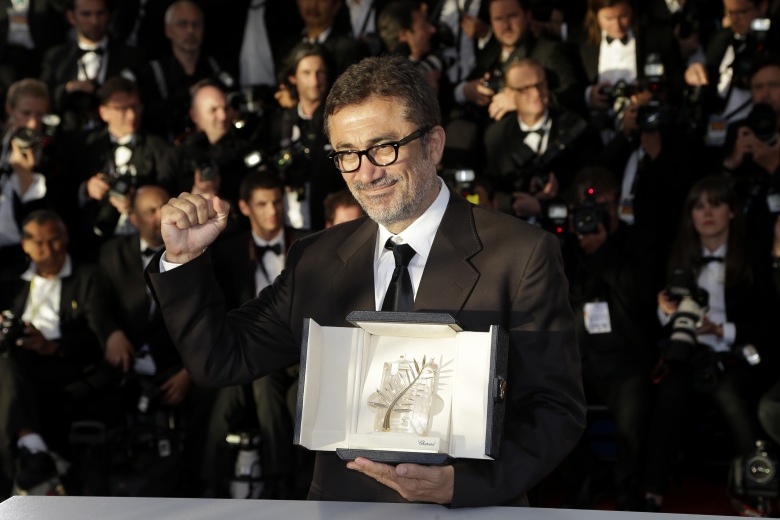
Nuri Bilge Ceylan poses with his Palme d’Or award for “Winter Sleep” at Cannes in 2014
Thibault Camus/AP/REX/Shutterstock
Some Palme winners appear to come out of nowhere, while others are preceded by the auteur in question picking up smaller prizes along the way. Nuri Bilge Ceylan’s “Winter Sleep” falls into the latter category — “Distant” had already won Best Actor, “Three Monkeys” Best Director, and “Once Upon a Time in Anatolia” took home the Grand Prix — but that doesn’t mean it wasn’t worthy. A slow, gorgeously shot meditation on class inequities in Turkey and beyond, it has the feel of a fable without being overt in its moralizing. Ceylan’s cinema may be an acquired taste, but it’s also a deeply satisfying one. —MN
If you’ve never seen Maurice Pialat’s adaptation of the novel by Georges Bernanos, your first question is probably whether it lives up to that title. The answer is an emphatic yes: Gérard Depardieu, in one of his best performances, plays a devout priest whose dalliance with a young murderess may actually be a form of Satanic temptation. Its Palme d’Or, the first for a French movie in 20 years, was seen as such an event that then-President François Mitterrand wrote Pialat a letter of congratulations in which he said that the film “shows the vitality that can and should characterize French cinema.” If you only know Depardieu for his more recent antics, allow “Under the Sun of Satan” to completely recast your perception of him — and, perhaps, the very concept of divine grace. —MN
Director Emir Kusturica’s visual inventiveness and frenetic pacing – which often feels like Fellini on adderall, accompanied by a raucous Balkan brass band – this time extends to the troubled history of his beloved Yugoslavia, which was in an extended period of disintegration. “Underground” is an ambitious three-hour farce (there was a five-hour version for television) about what happens to the soul of a country and its people living in a constant state of war for 50 years. The twists of the plot are as absurd as they are troubling: Marko, a rising leader in the communist party, keeps his friends hiding in the cellar convinced the Gestapo is still going door to door 15 years after the war is over. But nothing can stop Kusturica’s boisterous characters from drinking, fighting and fucking. –CO
Winner of the Palme d’Or at Cannes 1997, Abbas Kiarostami’s “Taste of Cherry” is one of the festival’s more divisive winners. Roger Ebert famously hated the movie, calling it “excruciatingly boring,” but something about Kiarostami’s patience and cross-cutting between close-ups and vast landscape shots creates an undeniable spell over the viewer. The film stars Homayoun Ershadi as a man driving through Tehran looking for someone to agree to bury him under a cherry tree after he commits suicide. The approach puts Kiarostami’s main character under a microscopic lens as the viewer parses through his movements for answers. The more the man comes into focus, the more “Taste of Cherry” invites moviegoers into Kiarostami’s maze of self-reflection. —ZS
Director Shōhei Imamura has always been under-appreciated, with the notable exception of Cannes, where two of his late career gems won the Palme. There was often a cinematic exuberance and playfulness to Imamura’s earlier films, but in this story of the 19th century Japanese practice known as ubasute – an elderly parent is carried up the mountain and left die the age of 70 – he shows tremendous restraint. The camera and storytelling allow for subtleties of the performance set against the beauty of the rural landscape to carry the story. Sumiko Sakamoto gives a remarkably understated performance as a woman who excepts her fate, but needs to find her eldest son a wife before he carries her up the mountain. —CB
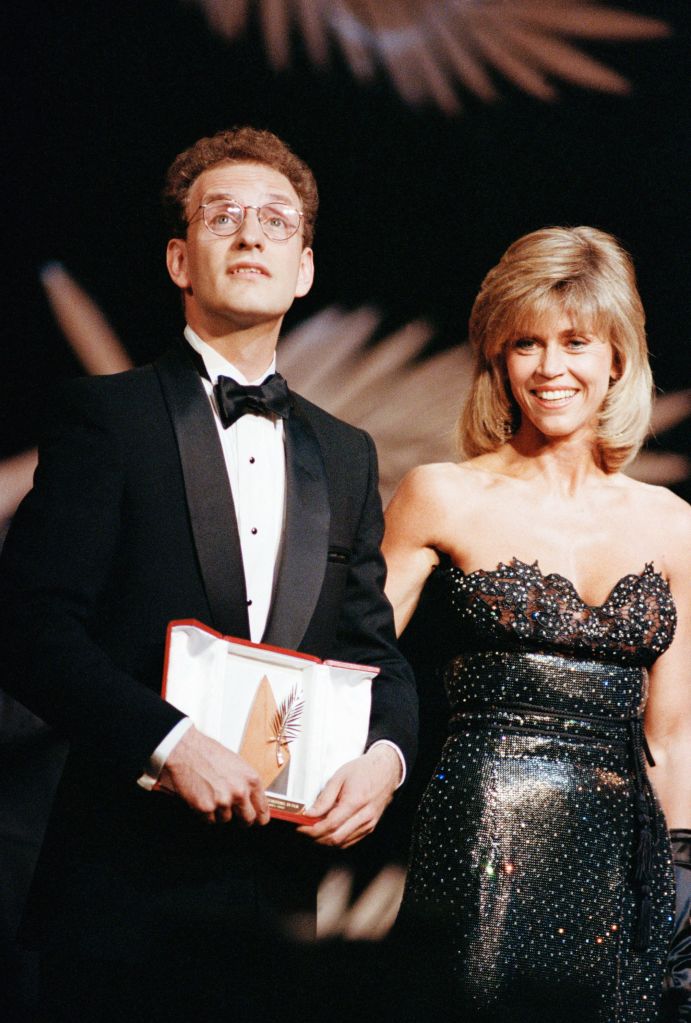
U.S director Steven Soderbergh, left, holds the Golden Palm he was awarded for his film “Sex, Lies and Videotapes” at the 42nd International Film Festival in Cannes, France . Next to him is actress Jane Fonda
Film Festival Cannes, Cannes, France
Gilbert Tourte/AP/REX/Shutterstock
A remarkable debut feature from Steven Soderbergh, who handles the film’s themes of sexuality and obsession with incisive humor and sensuality. The erotic dramedy stars James Spader as Graham, a long-lost college friend who drifts back into town and into the lives of John (Peter Gallagher), a self-involved playboy, his saintly wife Ann (Andie MacDowell ), and her cheeky sister Cynthia (Laura San Giacomo). Each is gradually drawn into Graham’s web of sex, lies and videotapes, and is left transformed. Spader scored the Best Actor prize at the Cannes Film Festival for his exceptionally subtle and provocative performance in a well-executed film that features riveting performances across the board. Soderbergh was nominated for an Academy Award for his screenplay. —TO
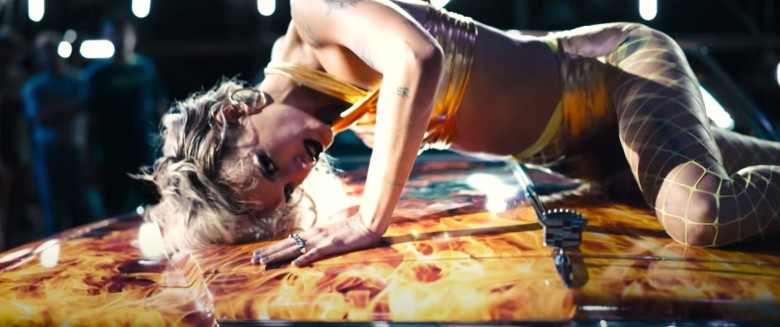
“Titane”
Courtesy Everett Collection
Spike Lee was the jury president who awarded the Palme to Julia Ducournau’s body horror shocker, and his enthusiasm was evident. So much so that he accidentally let slip that it won the top prize at the beginning of the 2021 award ceremony. “I’ve seen a lot of films, but this is the first film ever where a Cadillac impregnated a woman,” Lee said at the press conference afterward. “That blew my mind! That’s genius and craziness together. And those two things often match up.” Yes, “Titane” will be forever known as the movie where Agathe Rousselle has sex with a vintage Eldorado. But that all takes place only in the first third of the movie! Where Ducournau takes audiences after that is truly surprising: this is a movie that mixes the punishing and the sweet like almost no other. Rousselle’s character blends gender boundaries, species boundaries, even the line between animate and inanimate, as she eventually finds a caretaker in the captain of a fire brigade (Vincent Lindon). It’s not a perfect movie, and Ducournau’s emphasis on sensation may result in muddled ideas, but it is a lizard-brain experience like no other.—CB
23. “The Cranes Are Flying” (195
The first three honorees of the Palme d’Or were by any measure unchallenging: “Marty,” the Jacques Cousteau doc “The Silent World,” and “Friendly Persuasion.” But the fourth Palme d’Or winner is electric and deserves to be ever so much better known among cinephiles today: “The Cranes Are Flying” is a dizzyingly subjective character study about the lives of Soviet civilians enduring urban destruction and deprivation during World War II. At one point, the lead female character’s rape by a draft dodger is juxtaposed with a German aerial assault, an in-your-face expressionistic choice to pair personal terrorism with the terrorism of falling bombs that underscores the lasting psychological scars that come from both. This is a deeply empathetic movie in which the emotions never get lost in what is some of the showiest black-and-white images ever put on screen, courtesy of master Soviet director Mikhail Kalatozov and his go-to cinematographer Sergei Urusevsky. They would repeat the long tracking movements, complicated naturalistic blocking, Dutch angles, and extreme high-contrast lighting effects of “The Cranes Are Flying” in two equally stunning, if less emotionally fulfilling follow-ups, the wilderness survival tale “Letter Never Sent” and revolutionary potboiler “I Am Cuba.” —CB
Marcel Camus’ 1959 vibrant classic (also a winner of the 1960 Academy Award for Best Foreign Language Film) is loosely based on Orpheus and Eurydice of Greek mythology, with Rio de Janeiro, Brazil, during Carnival season, as the backdrop. Orpheu (Breno Mello) falls in love with Eurydice (Marpessa Dawn), and the pair must go on the run from a hitman dressed like Death (Ademar Da Silva) and Orfeu’s vengeful fiancée Mira (Lourdes de Oliveira) in this magical realist tragedy. The film features a samba musical score by Luiz Bonfa and Antonio Carlos Jobim. Its notable soundtrack is credited with single-handedly introducing the Bossa Nova to the rest of the world. It’s a fresh, colorful, atmospheric, and infectious take on an iconic fable. —TO
“The Go-Between” is one of the great memory movies from director Joseph Losey and screenwriter Harold Pinter, adapted from L.P. Hartley’s popular novel, and containing the unforgettable opening line: “The past is a foreign country; they do things differently there.” Set in 1900 on a sweltering August in a Norfolk country estate, the movie haltingly travels back and forth in time, 50 years, telling a gripping rite-of-passage story about the corruption of innocence, love, and beauty. Sweet and imaginative Leo (Dominic Guard) spends the summer holiday with boarding school friend Marcus (Richard Gibson), playing games and conjuring spells, trying to fit in above his class. Then Leo falls under the spell of Marcus’ beautiful older sister, Marian (Julie Christie), who entices him to be her private messenger, passing letters back and forth with her secret lover, the tenant farmer, Ted (Alan Bates). But what begins as a romantic game becomes a curse for Leo (with the adult version played by Michael Redgrave). Shot by Gerry Fisher with a sense of opulence and decay, and punctuated by Michel Legrand’s haunting score (with dueling pianos), “The Go-Between” endures as a bitter assessment of the 20th century. —BD
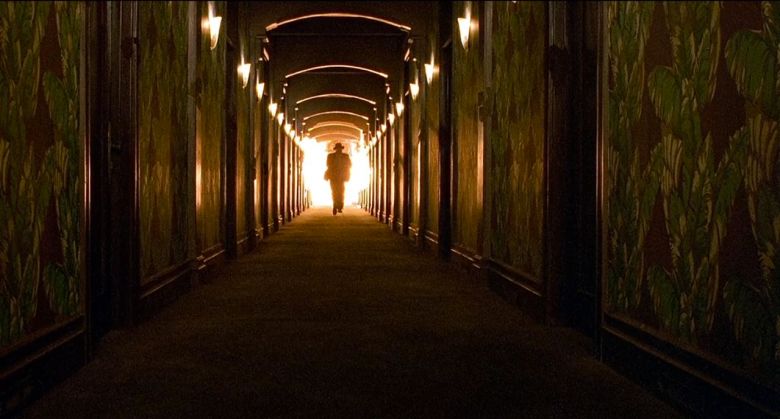
“Barton Fink”
The Coen Brothers’ hysterical 1940s Hollywood satire stars John Turturro in his greatest performance a Broadway playwright who reluctantly relocates to Hollywood to work as a screenwriter. Commissioned to write a low budget script about wrestling, Fink develops severe writer’s block…and weird stuff starts to happen. The clock ticks and the pressure mounts as Barton’s life spins further out of control. Turturro leads a solid cast that also includes John Goodman, Judy Davis, Michael Lerner, John Mahoney, Tony Shalhoub, Jon Polito and Steve Buscemi. Carter Burwell’s evocative score and Roger Deakins’ splendid cinematography complement the surreal sense of Hollywood’s Golden Age closing in on itself. The film received three Oscar nominations, including Best Supporting Actor for Lerner. Turturro and Joel Coen would receive Best Actor and Best Director honors at Cannes, in addition to winning the Palme. —TO
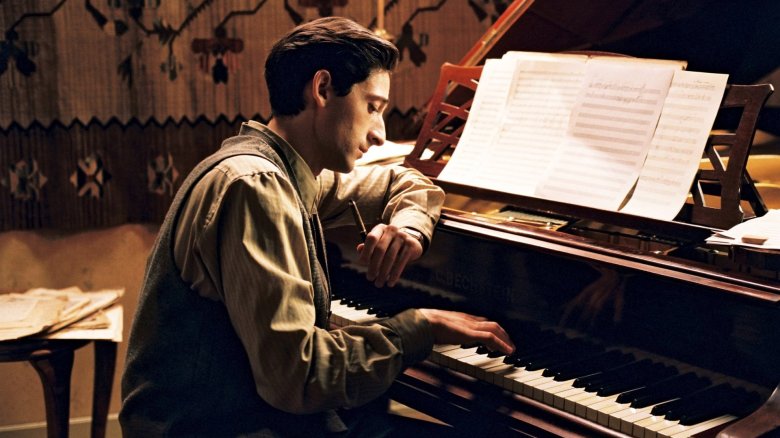
“The Pianist”
One of the greatest — perhaps the greatest – Holocaust movies ever made. After all, how many filmmakers of Roman Polanski’s talent are Holocaust survivors themselves? Though he remains a polarizing figure for many in Hollywood, the emotion and humanity in “The Pianist” was enough to suspend judgement of Polanski, if not morally then at least artistically. How fitting that the film should be a meditation on the nature and currency of art and artists in a morally depraved society. But it wasn’t Polanski’s efforts alone that made the film such a stunner; “The Pianist” introduced the monumental talent of future Oscar winner Adrien Brody — the distinguished figure delivered a career-making performance as Polish-Jewish musician Władysław Szpilman. When Polanski’s name was announced as Best Director at the 2002 Academy Awards, he received a standing ovation in absentia. Such is the power of “The Pianist.” —JD
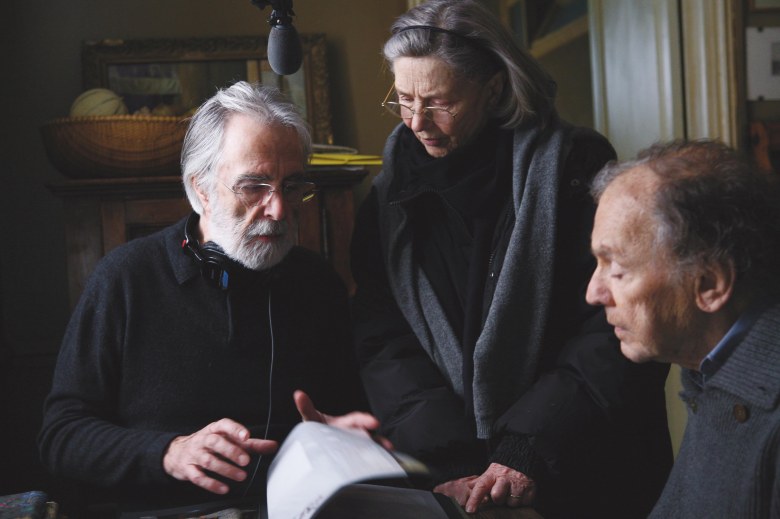
Michael Haneke gives notes to Emmanuelle Riva and Jean-Louis Trintignant
on the set of “Amour” (2012)
Wega Film/Kobal/REX/Shutterstock
Austrian auteur Michael Haneke has always known his way around tragedy, but the 2012 Palme winner opened up still more spaces in his particular brand of beautiful, hard-pounding misery. Rightly termed a “romantic tragedy,” the film picks up with one half of the film’s central couple already dead, then works backwards to make us understand why it happened (and why that ending might not be a total tragedy). Toplined by bonafide cinematic legends Jean-Louis Trintignant and Emmanuelle Riva (with Haneke regular Isabelle Huppert as their adult daughter), “Amour” is a love story with its own distinctive beats, and it starts when the wheels have come off, the bloom is off the rose, and all the shine is gone. What’s left then? Haneke and his stars work towards an unavoidable, heartbreaking ending (and, well, also a beginning) and endeavor to give it all the shades that a decades-long union can possibly hold. The sting is profound, but it’s also one that’s earned and honest, a tragedy made terribly personal. —KE
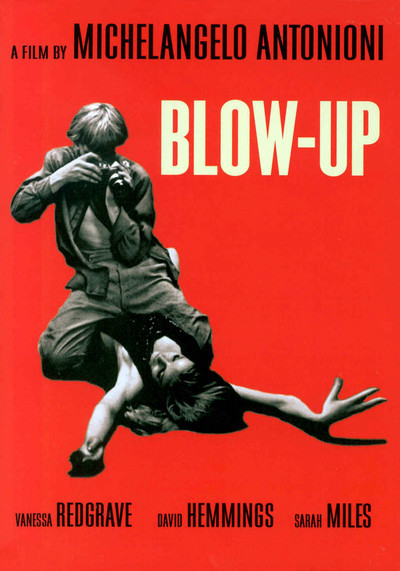
Michelangelo Antonioni’s mystery thriller “Blowup” won top honors at the 20th Cannes Film Festival in 1967 and went on to inspire classics such as Coppola’s “The Conversation” and De Palma’s “Blow Out.” David Hemmings stars as a London fashion photographer who may or may not have captured a murder on film, the answer to which leads to a dark obsession. Antonioni’s direction digs beneath the surface of the film’s counterculture setting and visual flair to create a statement on the artist’s relationship to art and the ebbs and flows of satisfaction and isolation that come with it. The final result is one of cinema’s great meditations on art, but disguised as a murder mystery thriller. —ZS
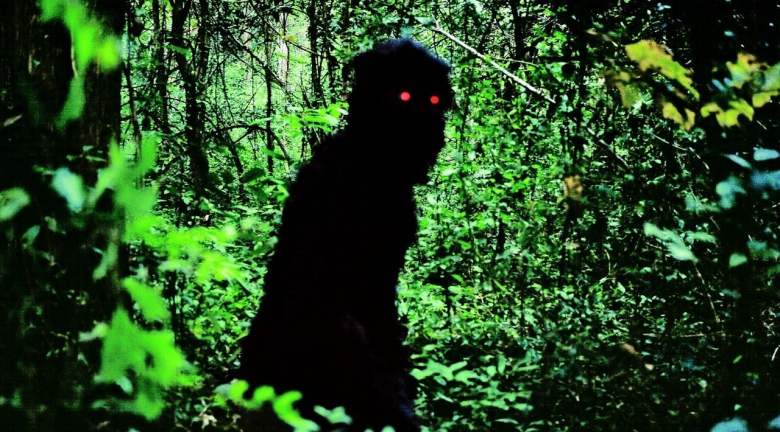
“Uncle Boonmee Who Can Recall His Past Lives”
Exhibit A when it comes to “Reasons to Be Excited About and Still Believe in Cinema in the 21st Century” is Apichatpong Weerasethakul. His films aren’t just enveloping environments, they’re radically empathetic avant garde comfort food: you could do worse than just making one of your at-home TV screens devoted to playing the Weerasethakul filmography on a loop. Really any of his films is Palme d’Or worthy and it’s hard to see why “Uncle Boonmee” is any more than “Tropical Malady” or “Syndromes and a Century” or “Cemetery of Splendor”: “Uncle Boonmee” certainly bears many of the hallmarks of these others – sound design so immersive it seems to awaken your senses, depiction of medical treatment, the mixing of hyper-realism and surrealism, a determined effort to stimulate delta and theta wave activity in your brain. That last part is no joke: believing moviegoing to be similar to a state of sleeping and dreaming, Weerasethakul has actually experimented with roadshow theatrical experiences in which people lay down in cots while they’re watching one of his films and are encouraged to go to sleep. “Uncle Boonmee” may be the one that most feels like a security blanket, in its depiction of an aging man with kidney failure who is revisited by the ghosts of his lost loved ones. Even a throwaway line when he’s talking about his dialysis and says, “This is karma because I killed too many communists… and so many bugs around the farm” can’t diminish your very real affection for him. Life is full of horrors. Here are films that make life better. —CB
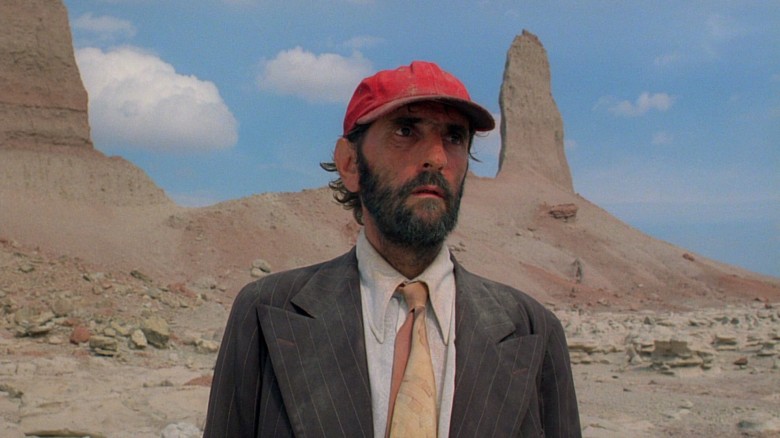
“Paris, Texas”
Harry Dean Stanton wandering through the West Texas desert. A pink sweater, just fuzzy enough to catch on whatever passes by. Ry Cooder, slamming on his slide-guitar, entire lives reverberating between each note. A lifetime of home videos shot on a Super 8 camera. Nastassja Kinski staring at her reflection in a one-way mirror and listening to the familiar voice on the other side as it tells her a story about “these two people” he once knew.
Wim Wenders’ “Paris, Texas,” which stood head and shoulders above the other films in Competition at Cannes in 1984, is one of those movies that burrows into your body from several directions at once, and then begins to collect at the bottom of your mind like the sand in an hourglass. Soft and impenetrable at the same time, this semi-mystical drama (or is it a thoroughly modern Western?) begins with a man stepping out of the past, reuniting with the young son he left behind, and then tracking down the beautiful woman with whom he once lived “in a place without language or streets,” and built a paradise that was never as strong as the memories buried in its ruins.
A story of restlessness, of wanderings, of private demons and shared dreams, and of the promise and betrayals of the American expanse, this Palme-winner is a singular ode to all that we’ve lost but can’t leave behind. It’s also a document of several major artists coming together to complement one another, from Wenders’ transcendent direction, to Robby Müller’s dusty camerawork, L.M. Kit Carson and Sam Shepard’s spare and poetic screenplay, to the role that Stanton was born to play. No map of the 20th century’s greatest films is complete with a pin in “Paris, Texas.” —DE
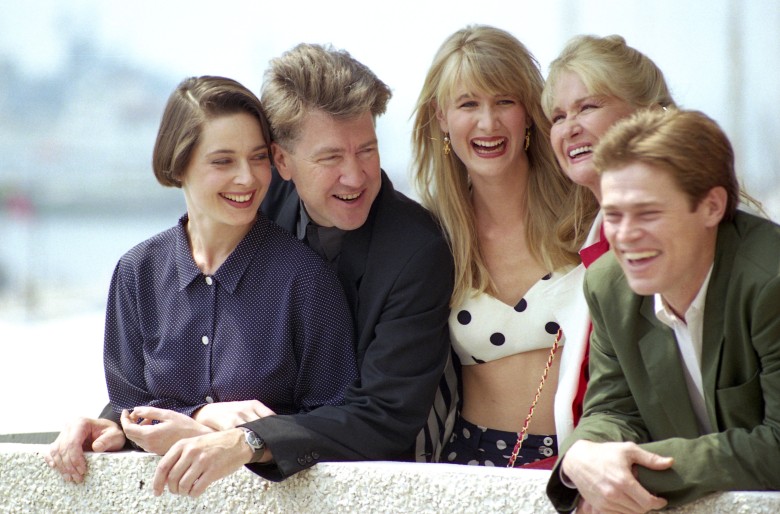
The “Wild at Heart” team at Cannes in 1990
Alan Davidson/Silverhub/REX/Shutterstock
Both adored and booed at Cannes during its 1990 premiere, the highly perverse and exhilarating “Wild At Heart” marks the only Palme d’Or win of David Lynch’s career thus far. The script pairs an oversexed Nicolas Cage and a lustful Laura Dern as two lovers escaping the past on a twisted road trip through an America heartland turned hellscape. Lynch proves a master of tonal shifts here, effortlessly balancing over-the-top hilarity with psychosexual thrills that manage to upend the lovers-on-the-run subgenre and speak to an America in freefall. “Wild At Heart” is fearless filmmaking in every sense of the word. —ZS
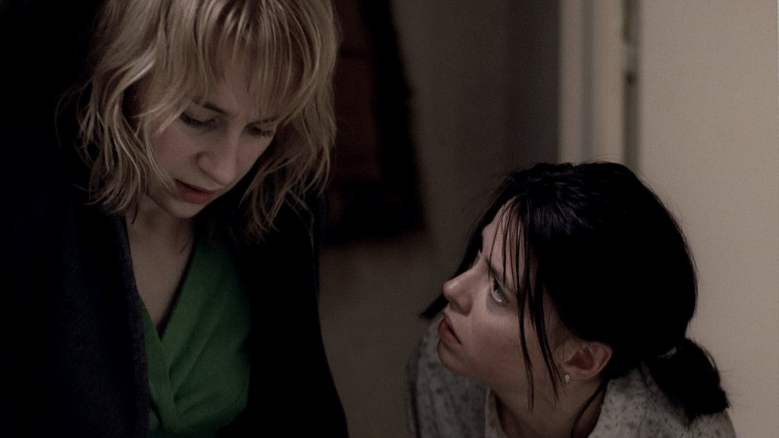
“4 Months, 3 Weeks and 2 Days”
It says a lot that “4 Months, 3 Weeks and 2 Days” won the Palme d’Or the same year that “No Country for Old Men,” “Zodiac,” “Secret Sunshine,” “Silent Light,” and “The Diving Bell and the Butterfly” premiered at Cannes and no one complained. Cristian Mungiu’s devastating look at abortion in his home country announced the Romanian New Wave to the world in a way that not even “The Death of Mr. Lăzărescu” or “12:08 East of Bucharest” did, showing the many ways in which the oppressive reign of Nicolae Ceaușescu continued to echo nearly two decades after the dictator’s death. Its triumph at Cannes was especially important given its Oscar snub, which still stings more than a decade later. —MN
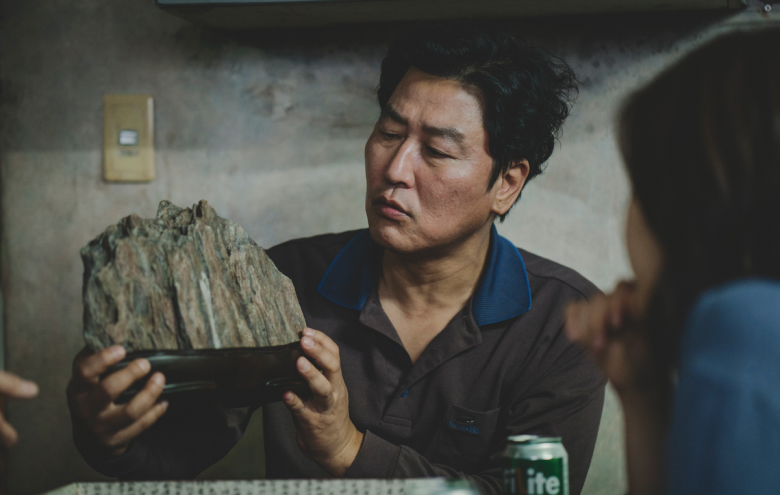
“Parasite”
Neon
To think that Bong Joon Ho had been booed at the festival just two years earlier! But that’s what working for Netflix, as Bong did with “Okja,” will get you at Cannes. In “Parasite,” the director rebounded with the first Korean movie ever to win the Palme — and first non-English-language movie to win best picture at the Oscars to boot. As full of energy and entertainment value as ideas, “Parasite” thrills with its narrative twists, all of which power the argument that many people outside the 1% are just living by a thread. Song Kang-ho plays the patriarch of a family of talented grifters who infiltrate a wealthy household one by one. But who’s really being exploited? What follows is as clear and compelling a dramatization of trickle-down economics as the big screen has ever seen. —CB
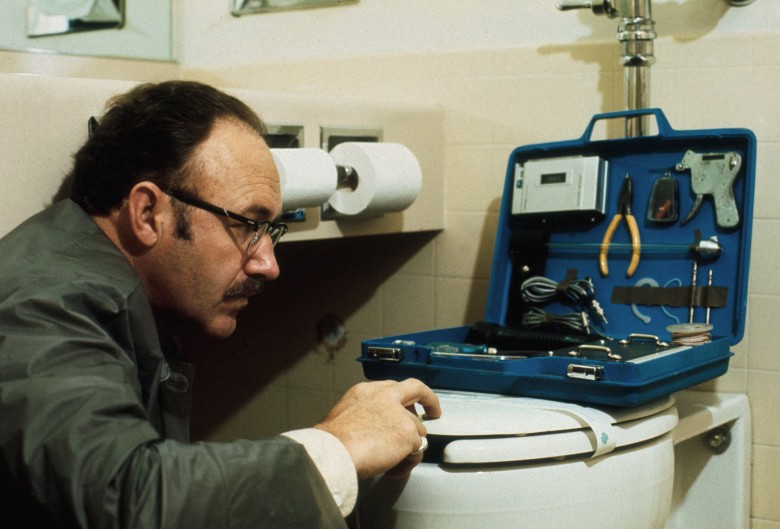
Gene Hackman in “The Conversation” (1974)
Moviestore/REX/Shutterstock
Francis Ford Coppola has never wanted to make life easy for himself. After the biggest success of his career in “The Godfather,” which broke box office records, won the Academy Award for Best Picture, and, well, instantly became one of the most beloved films of all time, he could have just rested on his laurels and prepped “The Godfather Part II.” Instead he earned another laurel — a literal laurel in the Palme d’Or — for one of the most challenging cinematic achievements of his career, and an exciting means of challenging American cinema to try new things. “The Conversation” is a self-consciously arty deep dive into an obsessive quest for meaning as embodied by a private detective named Harry Caul (Gene Hackman), who thinks a wealthy businessman (Harrison Ford) plans the murder of his wife (Cindy Williams) and her lover because of a snatch of their conversation he recorded: “He’d kill us if he had the chance.” But what does that single sentence actually mean? And how would that meaning change depending on intonation and context? Think “Blow-Up,” but rendered as an unrelenting portrait of loneliness too: this is one of Hackman’s most remote, unknowable characters. Popeye Doyle seems warm and fuzzy when compared to Harry Caul. —CB
10. “Shoplifters” (201

“Shoplifters”
It’s not just that sitting through the mostly delightful, at times heartbreaking, two-hour running time of “Shoplifters” feels like being part of a family that is entirely foreign to most people, but thanks to the warmth of the characters and the intimacy of Hirokazu Kore-eda’s filmmaking, you feel completely at home. Captivating from first frame to last, Kore-eda’s Palme winner expertly weaves together a moving family drama, then slyly pulls apart its threads until the rug isn’t just pulled out from under you — it’s entirely disintegrated. Each adult character contains knots of contradictions, their charm making them infinitely compelling even after their unseemly truths are revealed. The performers, both children and adults, riff off each other more like a theatrical ensemble than a film cast, and their natural ease and chemistry grounds the outlandish story. Like its characters, “Shoplifters” is a big movie — in scope, ambition, and heart — that excels at rendering indescribable little moments as only great art can. —JD
This could have been yet another woe-is-me story of a young person’s horrible childhood and their triumphant transcendence of it in their early adulthood: “Padre Padrone” is based on celebrated linguist Gavino Ledda’s story of growing up as a shepherd boy on Sardinia and the horrific treatment he endures at the hand of his tyrannical father – Ledda was even illiterate until nearly the age of 20 before embarking on a world-renowned academic career. But in the hands of Paolo and Vittorio Taviani, this story becomes something so much more: far from just a wallowing in miserabilism, “Padre Padrone” becomes one of the most surreal and singular coming of age stories ever filmed – at one point one of the goats young Gavino keeps trying to milk actually addresses Gavino directly in voiceover narration. Yes, the goat is a narrator – one of many in this prismatic story that gets meta from the start and ultimately becomes as much about the nature of storytelling as anything. The early scenes of young Gavino, having just been pulled from school, and on an extended sojourn with his father’s flock feel like they could be set on another planet. It’s one of the most Jodorowski-esque visions ever to come from someone other than Jodorowski. —CB
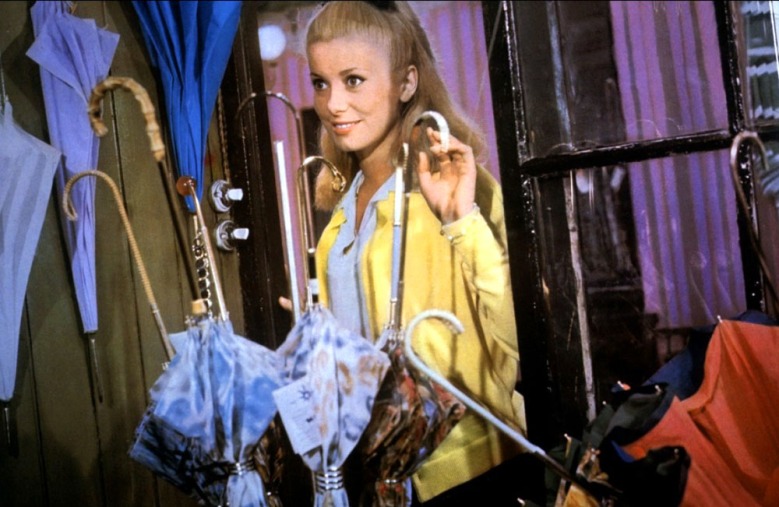
“Umbrellas of Cherbourg”
One of the best, most influential musicals ever made, Jacques Demy’s sung-through delight wasn’t just successful at Cannes — it also received five Oscar nominations, three of which were for its music. Degrand and revered composer Michel Legrand put together a three-part tapestry for Catherine Deneuve and Nino Castelnuovo’s characters to sing their way through, and though “I Will Wait for You” remains the best-known song it’s hardly the earworm. A romantic drama for the ages, “The Umbrellas of Cherbourg” also has the rare distinction of being as much a visual treat as it is a musical one. —MN
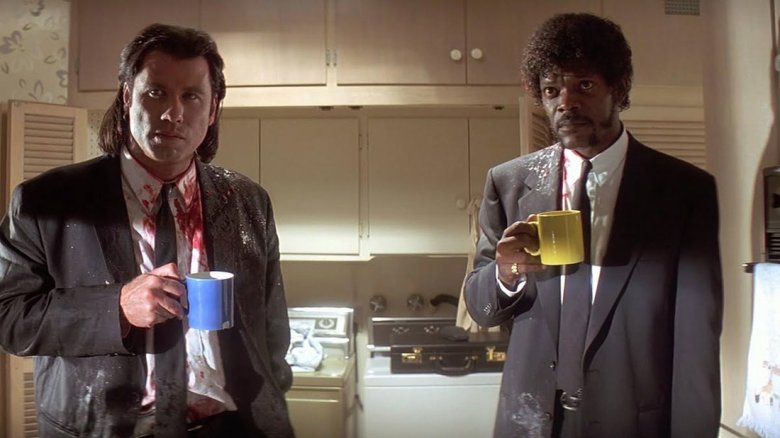
“Pulp Fiction”
Miramax
Lo these many years later, even Quentin Tarantino’s most discerning fans can’t argue with calling his Palme d’Or winner his best film. For better or worse, there are few films on this list as culturally relevant as “Pulp Fiction” — echoes of “Zed’s dead, baby” and that famous dance scene will ripple across pop culture in perpetuity. Sandwiched between “Reservoir Dogs” and “Jackie Brown,” “Pulp Fiction” established Tarantino as the ultimate postmodern filmmaker, able to turn a dizzying homage stuffed with countless cinematic references into a fiercely original lightning rod of a movie that would forever alter independent film. When you think about just how many rules Tarantino broke to make “Pulp Fiction,” it’s a wonder it won over the establishment in Cannes at all. —JD
Akira Kurosawa delivered two of his greatest cinematic achievements in the twilight of his career, and both were the sort of costly, ambitious period piece epics that many filmmakers spend their lives fighting to make. With “Kagemusha” and “Ran,” Kurosawa managed to deliver a pair of historical masterpieces about Japan’s bloody history of warring kingdoms and passionate leaders. Kicking off 1980 with “Kagemusha,” Kurosawa won his first Palme d’Or when many filmmakers may have settled for an honorary lifetime achievement award (he won one of those, an Oscar, 10 years later). That victory alone (which was thanks in part to Kurosawa super-fan George Lucas, who helped the project secure American studio support) makes this one a winner for the ages. But “Kagemusha” has only grown richer with time. The filmmaker’s vivid drama involves the story of a wayward thief consigned to working as the decoy for an ailing lord (Tatsuya Nakadai, in both roles) to hide his illness; when the leader dies, his double is forced to keep up appearances, for both the clan itself and warring factions. Eventually, the “kagemusha” (a political decoy) settles into his illusion of power with devastating consequences. The movie becomes a fascinating meditation on the desperation of a fading people fighting to keep up appearances as Japan consolidated its power on the battlefield. The climactic showdown — a sprawling recreation of the Battle of Nagashino, when thousands of lives were lost — is a masterclass of narrative finesse: Kurosawa juggles the movements of massive armies in tandem with the reactions of a single, baffled spectator as he wrestles with the horror of war and the ideological sting of defeat. This is personal filmmaking writ large, and a visionary achievement by a filmmaker funneling his decades of achievements into every frame. —EK
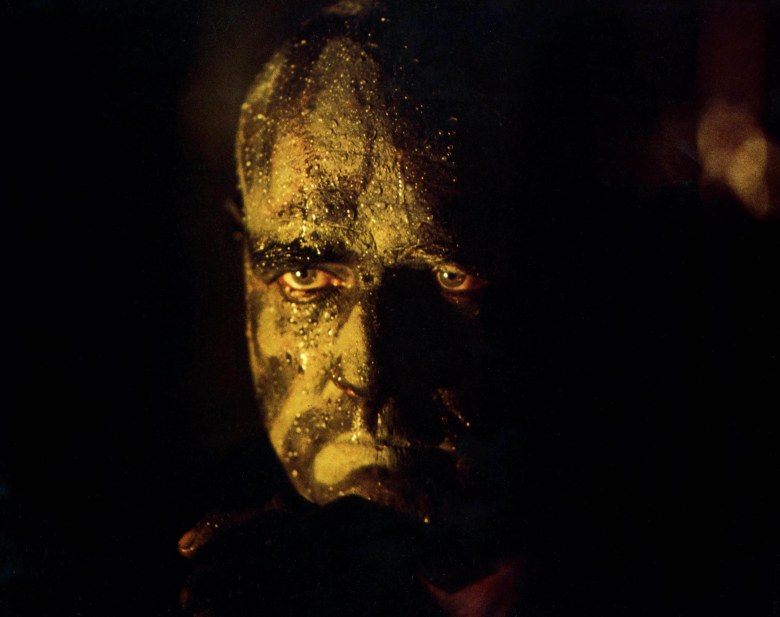
“Apocalypse Now”
Zoetrope/United Artists/Kobal/REX/Shutterstock
“This is the end,” croons Jim Morrison of The Doors as fire strikes light up a line of trees in Vietnam. Beaded with sweat, Army Special Operations Officer Captain Willard (Martin Sheen) smokes in bed, staring at a ceiling fan before embarking on a surreal, drug-infused boat journey up the river from South Vietnam to Cambodia to find rogue Colonel Kurtz (Marlon Brando). Freely adapted by Coppola and John Milius from Joseph Conrad’s “Heart of Darkness,” “Apocalypse Now” boasts so many iconic moments that it’s hard to recall that it was expected to be a complete disaster. “I love the smell of napalm in the morning,” intones bare-chested surfer Colonel Kilgore (Robert Duvall). Helicopters fly in formation over the sea, accompanied by Wagner’s “Ride of the Valkyries.” After years of delays in the Philippines, including Sheen’s heart attack and sets destroyed by typhoons (chronicled by Eleanor Coppola in “Hearts of Darkness: A Filmmaker’s Apocalypse”), Francis Ford Coppola screened “Apocalypse Now” as a three-hour work in progress at Cannes, where the rapturous reception was enough to give the beleaguered director some confidence to finish his cut so that United Artists could release it in August—with state-of-the-art surround sound—when it was a hit. (Coppola’s new “final” 4K Dolby Atmos version just screened at the Tribeca Film Festival.) The movie tied for the top prize with “The Tin Drum” and beat out “Norma Rae” and “Days of Heaven.” It is now widely considered one of the best movies ever made. —AT
When a film wins the Palme d’Or, is banned in its home country, and gets denounced by the Vatican, it must be doing something right. Such is the case with Luis Buñuel’s 1961 masterpiece, which feels no less daring today than it must have nearly 60 years ago. The surrealist master here turns his attention to a novitiate whose plan to take her vows is complicated by an invitation to visit her uncle — a man who sees in his niece a resemblance to his dearly departed wife. What follows is scandalous, of course, and portrayed with the kind of wit and mastery that Buñuel made a career from. As for his intentions, the filmmaker put it as only he could: “I didn’t deliberately set out to be blasphemous, but then Pope John XXIII is a better judge of such things than I am.” —MN
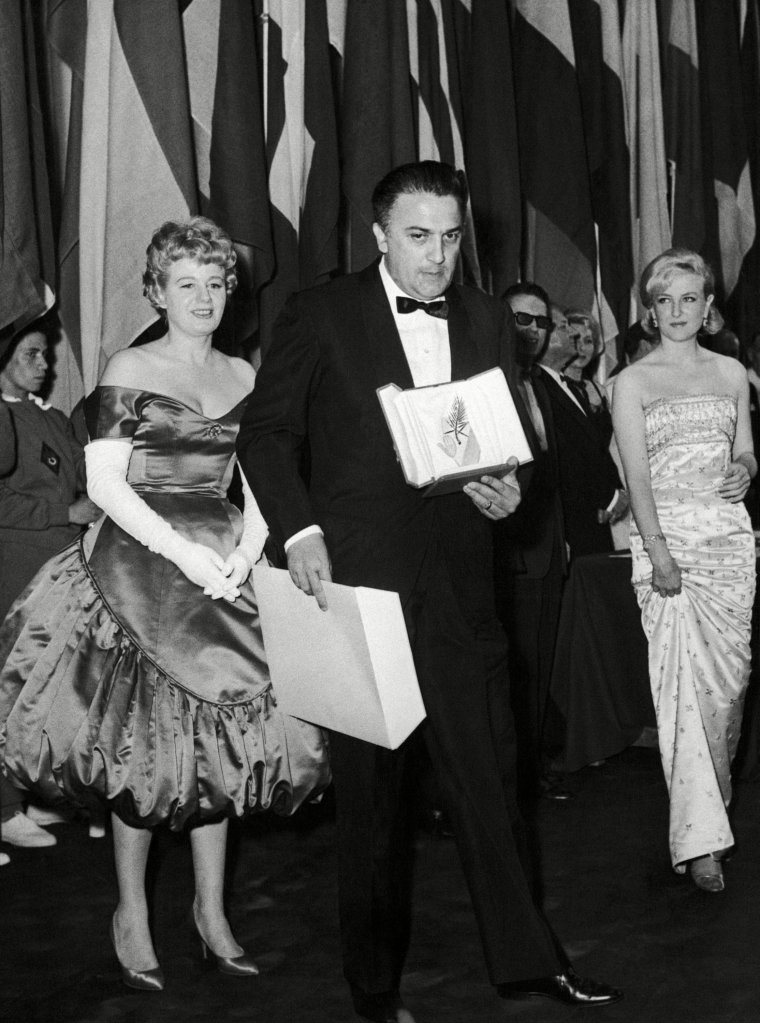
Fellini with the Palme d’Or
Wehrle/AP/REX/Shutterstock
Perhaps the definitive Cannes crowdpleaser, Federico Fellini’s magnum opus is an lush story about searching for the eponymous sweet life over the course of just seven days in Rome. Fellini’s film was not only a massive hit, one that only sealed his place as one of cinema’s greatest filmmakers, but a movie that gave the world bold fashion, clever new sayings and words (hello, “paparazzi”!), and some incredibly rich existential questions to chew on. As celebrity journalist Marcello Rubini, Marcello Mastroianni is, was, and will always be a startlingly modern man, and the questions he faces as he revels through Rome — like, does he just want to have fun or does he actually care to do something meaningful with his life? — are timeless. But that doesn’t mean it can’t all be fun to watch, and while Fellini’s winner doesn’t let its audience off the hook when it comes to thinking about the real guts of life, it does it with so much style and snap that you almost (almost!) forget what it’s really asking of you. —KE
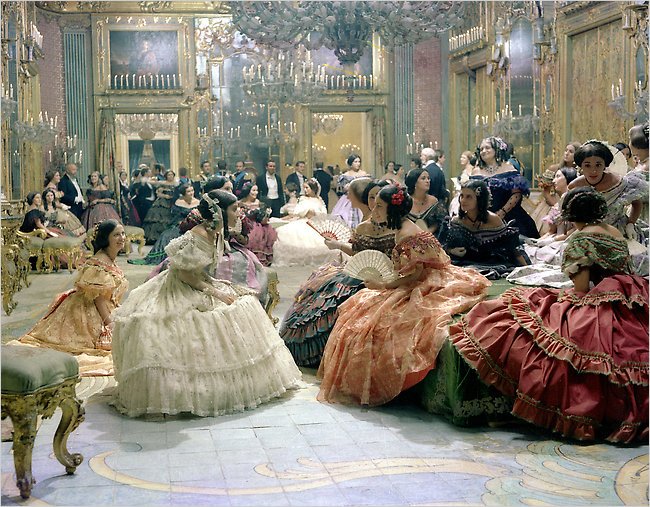
“The Leopard”
Underneath the lush trappings of Luchino Visconti’s 1963 winner beats the heart of the most tragic of personal and political dramas. Adapted from Giuseppe Tomasi di Lampedusa’s novel of the same name, the Italian epic follows the waning days of the Sicilian aristocracy through the eyes of the (sort of) eponymous leopard himself, Don Fabrizio Corbera (played by Burt Lancaster in one of his best roles, though his casting was controversial at the time). The film features two gob-smacking long sequences that alone would have marked the film as a masterpiece and crowning achievement for Visconti: a 25-minute battle scene that doesn’t skimp on the horror and a heart-stopping 45-minute ballroom sequence that sees Don Fabrizio cycling through nearly every emotion, every thought, every motion with thrilling emotional dexterity. It’s a film about the inevitable passage of time, but nothing about it feels (even now!) rote or by the book. Visconti’s first cut pushed a 205-minute runtime — no surprise, considering those gorgeous long sequences — and was cut down to 195 minutes for Cannes, then 185 minutes for an Italian release, with the English-dubbed version clocking in at 161 minutes. Still, it’s a film that demands to be seen in a full, because who could possibly know better that every minute counts than Don Fabrizio Corbera himself? —KE
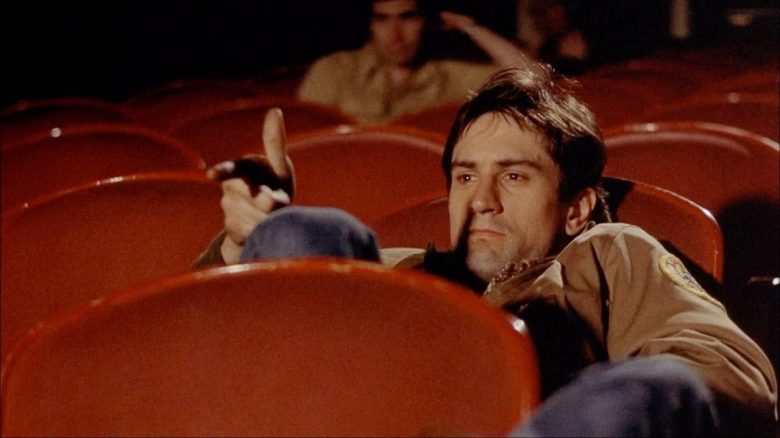
“Taxi Driver”
Columbia Pictures
Fellow Palme d’Or winner Quentin Tarantino once called “Taxi Driver” the greatest first-person character study ever committed to film and we aren’t here to disagree. What was so remarkable about this period in Scorsese’s career is that he could look a racist psychopath like Travis Bickle (Robert Deniro) squarely in the eye, make no excuses, nor polish any of his warts, but cinematically invite us into his world in a way that made us understand him. Scorsese’s hallucinatory imagery mixed with screenwriter Paul Schrader’s voiceover and composer Bernard Hermann’s brassy score create a nightmare vision of New York 1976 that is so filled with filmic exuberance that it’s as exhilarating as it is terrifying.
In true Paul Schrader form, the film sets us up to confront the violence and madness in an uncomfortable, bloody and jarring way by the end. It’s a controversial ending, the type that drives conversation in cinephile circles and repels viewers in hordes. And yet, over 40 years later this twisted, somber portrait of a psychopath isn’t merely a Criterion Collection gem, but an American film classic, quoted (“You talkin’ to me?”) and rewatched like it’s “Jaws” or “The Godfather.” There is no picture in film history that holds anything like the real estate occupied by “Taxi Driver.” —CO
Who would have known when we made the below list of every Palme d’Or winner ranked that the next three years would see only two additions to the list? For the first time since 1968, when the festival, in solidarity with the May 68 movement, was last canceled, Cannes didn’t happen. The planned 2020 edition of the festival was one of the countless events postponed due to the pandemic. And though a selection was announced and laurel leaves allowed to be used in the marketing for those films, no Palme d’Or was awarded. (Other times the festival was canceled was in 1948 and ’50, due to budgetary problems, and of course during World War II.)
“Parasite” and “Titane” are two of the most critically acclaimed Palme winners in some time. Of course, annual awards hype tends to drive the perception that the Oscar is the highest award in the film community. But for countless filmmakers and cinephiles around the world, the Palme d’Or comes out ahead. Ever since 1955, the Cannes Film Festival has assembled a discerning jury of A-listers to bestow this honor on an exclusive Competition section featuring some of the greatest auteurs the medium has known.
Originally known as the Grand Prix, the shimmering Golden Palm has played a key role in advancing careers, but it has just as often fallen to veterans of the form, and across seven decades juries have acknowledged an astounding range of cinematic accomplishments. But some of these prizes were worthier than others.
Here’s a look at all the Palme winners over the years, ranked in order of which ones we believe deserved it the most. Viewed as a whole, the winners provide a complex survey of international cinema from the past three quarters of a century, and anyone unfamiliar with these titles should consider the following list as an essential viewing guide.
With contributions from Tom Brueggemann, Jude Dry, David Ehrlich, Tambay Obenson, Chris O’Falt, and Anne Thompson.
73. “Fahrenheit 9/11” (2004)

Michael Moore at Cannes
Laurent Rebours/AP/REX/Shutterstock
The accolades for Michael Moore’s 2004 documentary are extensive: a reportedly 20-minute long standing ovation at Cannes, the highest box office take ever for a doc, Moore’s first (and, so far, only) Palme d’Or win. And yet that doesn’t mean it’s impervious to criticism or that it’s even held up in the 15 years since it first arrived on the Croisette. Both slavish and slapdash, what once seemed urgent and unsettling now just plays like agitprop without much to anchor it. Zipping between the tragedy of 9/11, George W. Bush’s military record, and an extended metaphor about burning paper, it’s a film that shows off Moore’s tendency toward blunt metaphor, with seemingly no restraint. Moore himself has come back from the film with better, tighter, more refined work, including last year’s “Fahrenheit 11/9,” which serves as a bit of a course correction to its predecessor. —KE
72. “The Silent World” (1956)
The first film Palme recipient, and one of two documentary winners, Jacques Cousteau’s account of his ocean studies on the Calypso pioneered underwater color photography. Co-directed by Louis Malle (presaging his later documentaries), it remains a visually strong film even as its content now feels familiar. At the time, it was eye-opening for audiences. Columbia released it theatrically in the U.S., and it also won the Best Feature Documentary Oscar. Viewed today, however, it hasn’t aged well: The storytelling has a naive quality and the filmmaking suffers from a sometimes uncomfortable sense of environmental recklessness. —TB
71. “Keeper of Promises” (1962)
Francois Truffaut was one of the jurors the year this obscure Brazilian religious fable won. It came the year after Bunuel’s heretical comedy “Viridiana” tied for the prize. This much more didactic tale, based on a play and top-heavy with dialogue (substantially filmed on the steps of a church where a peasant is attempting to make an offering). The conflict comes when the fearful clerical hierarchy fears his efforts are tainted by voodoo. This is about as a strange a Palme winner in history. It was an Oscar Foreign Language nominee, but even with the dual distinctions didn’t get released in the U.S., and then barely, until 1964. The same period saw the birth of of Brazil’s Cinema Nuovo, one of the most important national new waves of the ’60s. It remains the sole Brazilian winner, and the only one of Duarte’s films to have significant exposure abroad. —TB
70. “I, Daniel Blake” (2016)

“I, Daniel Blake”
English director Ken Loach won his second Palme d’Or after “The Wind That Shakes the Barley” with his harrowing 2016 kitchen sink drama “I, Daniel Blake.” Told with Loach’s trademark matter-of-factness, the film focuses on the story of a 59-year-old heart attack survivor fighting to receive financial support from England’s welfare system. The subject matter is almost too bleak. Loach’s script sticks to an oppressive tone, offering little moments of levity or surprise for those willing to endure its punishing details. Only the two performances Loach gets out of Dave Johns and Haley Squires elevate the otherwise grim tone. Squires in particular delivers unforgettable work as a down-and-out single mother who befriends the title character. Loach’s script forces both actors to go through an emotional wringer, and it’s the way they come out the other side with humanity intact that makes “I, Daniel Blake” cross the finish line as an impactful drama, albeit one that can’t compete with the best of Cannes. —ZS
69. “The Son’s Room” (2001)

“The Son’s Room”
““The Son’s Room” might be worthy of a Palme d’Or, but it definitely wasn’t worthy of the Palme d’Or in 2001, when Nanni Moretti’s somber drama eked out a victory over a lineup of instant classics like “Mulholland Drive,” “Millennium Mambo,” and “The Man Who Wasn’t There” (and that’s just counting the Competition movies that started with the letter “M”). From that moment on, this aching little movie was doomed to an eternity of ranking towards the bottom of lists like this one. And that’s probably where it belongs.
Be that as it may, winning a prize it didn’t (at all) deserve is the worst sin that “The Son’s Room” commits. A feature-length Brian Eno commercial that’s cloaked in a tender, meditative portrait of a broken family trying to reassemble itself, Moretti’s film couldn’t be much simpler: The writer-director stars as a therapist whose life is warped by grief when his 17-year-old son drowns. Eventually, after much domestic strife and internal reflection, Giovanni and his wife (Laura Morante) come into contact with their late son’s girlfriend, and conscript her into helping them move on from their loss — a process that understandably involves listening to Eno’s “By this River” (maybe the most desolate song ever written) over and over and over again. “The Son’s Room” may not be the most innovative or ambitious film to premiere on the Croisette (in fact, it may be one of the least), but it understands the terrible thrums of grief, and compellingly grapples with the painful realization that losing someone means never getting them back. —DE
68. “Dheepan” (2015)

“Dheepan”
Seen by some as a career-achievement win for Jacques Audiard, who’d previously won two major awards at the festival (Best Screenplay for “A Self Made Hero” and Grand Prix for “A Prophet”), “Dheepan’s” victory wasn’t especially inspired. 2015 was also the year “Son of Saul,” “The Assassin,” “Carol,” and “The Lobster” premiered in Competition, and though none left the Croisette empty-handed, it was difficult even at the time not to feel like they’d been shortchanged. “Dheepan” certainly has its moments, from its striking title cards to Antonythasan Jesuthasan’s performance in the title role, but its violent, action-flick third act seems lifted from some other, lesser movie. —MN
67. “The Wind That Shakes the Barley” (2006)

British Director Ken Loach Poses with the Palme D’or Award He Won For His Film ‘The Wind That Shakes the Barley’
Christophe Karaba/EPA/REX/Shutterstock
The first and more deserving of Ken Loach’s two Palme d’Or winners, “The Wind That Shakes the Barley” still isn’t an all-timer. Cillian Murphy and Pádraic Delaney star as two brothers who join the IRA to fight for Irish independence in 1920, with Loach directing from a script by frequent collaborator Paul Laverty; like most of the filmmaker’s recent projects, this wartime drama is well-mounted but lacking the spirit that made the likes of “Kes” so compelling. That hasn’t prevented him from continuing to be a favorite at Cannes — he’s premiered a dozen films there and, in addition to these two Palmes, somehow won the Jury Prize for “The Angels’ Share” — and, even if “The Wind That Shakes the Barley” isn’t his finest hour, it’s hard to begrudge him the honor. —MN
66. “The Tin Drum” (1979)
Volker Schlöndorff’s “The Tin Drum” somehow managed to tie “Apocalypse Now” to win the film world’s greatest honor over “Days of Heaven” and “My Brilliant Career” (and you thought “Crash” beating “Brokeback Mountain” was a disgrace). Adapted from Günter Grass’ allegorical novel of the same name, Schlöndorff’s fable-esque epic tells the rambling story of a blond young boy named Oskar Matzerath (David Bennent), a Joffrey Baratheon-looking tyke who’s given a tin drum for his third birthday, and then vows never to grow old.
The year is 1927, the world is trying to restore some kind of rhythm between wars, and little Oskar has no interest in playing a role in whatever atrocities are about to come next; this insufferable little troublemaker — a stand-in for all the German people who dug their heads in the sand — just wants to bang on his drum and scream at the top of his lungs whenever he gets peevish (his shrill cries have the power to shatter glass). Bennent, who was 12 at the time of shooting, delivers a powerful, undiluted performance that gets under your skin and stays there for almost three hours, but the picaresque narrative fails to find a steady beat, and even its most unsettling episodes skitter along the surface of the ideas presented in Grass’ book. Oskar may never get old, but his movie does. —DE
65. “The Child” (2005)
Cannes loves few filmmakers like the Dardennes brothers, who joined the two-time Palme d’Or club with “The Child” in 2005. (They’d previously won it for 1999’s “Rosetta” and would go on to take home Best Screenplay for “Lorna’s Silence” and the Grand Prix for “The Kid with a Bike.”) Another example of their affinity for low-key realism focusing on the downtrodden, it follows a young, out-of-their-depth couple’s halfhearted attempts to eke out an existence after having a son — who, in his infinite wisdom, the father (frequent Dardenne collaborator Jérémie Renier) sells to a black-market adoption ring. Most of the cinematic siblings’ movies operate in this realm, but few are as moving — or as deserving of their Cannes laurels. —MN
64. “Marty” (1955)
Winner of the very first Palme d’Or, Delbert Mann’s “Marty” seems like too modest a thing to earn either of those awards, let alone both. The story of a butcher in the Bronx (Ernest Borgnine) who’s resigned himself to a life of bachelorhood — a shameful condition in those days — the film basically follows its self-loathing title character as he looks for a girl as “pathetic” as he is, and then tries not to let the one he finds (Betsy Blair) slip through his fingers.

“Marty”
Told with the austerity of an Ozu drama and the stick-your-face-in-the-mud sadness of “Make Way for Tomorrow,” “Marty” is a lonely heart love story that feels a lot bigger than it seems on the surface, especially once the hero’s mom (Esther Minciotti) comes to the fore and you realize how little she’s got to keep things together. The characters in Paddy Chayefsky’s script are products of their time (one moment, in which Marty badgers his date for a goodnight kiss, might be particularly hard to swallow for modern viewers), but there’s a palpable timelessness to their yens and yearnings, and Marty’s climactic soliloquy conveys a universe of human desire in just a few short sentences. In other words, Mann’s film still has more to offer than just being a fateful answer in “Quiz Show.” —DE
63. “Friendly Persuasion” (1957)
In William Wyler’s 1956 drama based on the 1945 novel by Jessamyn West, the faith and pacifism of a peaceful Quaker family, led by Gary Cooper, is tested during the Civil War. Dorothy McGuire and Anthony Perkins round out the starring cast of a film about a family struggling to maintain its identity amid confusion and heartbreak at wartime. Triumphant performances, beautifully shot alongside a great score by Dimitri Tiomkin, bolster this warm and lovely story that shows that, when it comes to what’s at the heart of family, there really isn’t that great of a gulf between the present-day and 150 years ago. The film may not be the most adventurous cinematic achievement in the history of Palme d’Or winners, but it was nominated for six Academy Awards, including Best Picture, Best Director, and Best Actor in a Supporting Role. —TO
62. “The Best Intentions” (1992)
Sweden’s Bille August won the Palme d’Or twice. Ingmar Bergman never did for any one film, though he was awarded a special Palme as the best living director to never have won at the festival’s 50th anniversary. This three-hour feature film from an intended longer television miniseries (similar to Bergman’s own “Fanny and Alexander,” which exists in both versions) follows that film’s story of his childhood with a somewhat speculative look at his parents’ relationship. Based on Bergman’s script (he chose the director), his wife Pernilla (a previous Bergman star) took the Best Actress prize. Max von Sydow also starred. It received less than unanimous critical praise, certainly much less than “Fanny” or August’s own “Pelle.” Its American release saw it among the 10 top subtitled releases of 1992, but with only a fraction of what “Fanny” did as well below “Pelle.” August followed with an increasingly conventional series of prestige films (including “The House of the Spirits” and the 1998 non-musical “Les Miserables,” recently less seen outside of Sweden. —TB
61. “Pelle the Conquerer” (198
Swedish director Bille August co-wrote and directed this sweeping mid-19th-century epic, which bears some similarity to Jan Troell’s lauded ’70s hits “The Emigrants” and “The New Land,” also starring Max Von Sydow. This time, the Ingmar Bergman veteran stars as an impoverished older Swedish man who emigrates to Denmark promising his young son Pelle (Pelle Hvenegaard) a better life. Instead, they find servitude to a brutal farmer (Axel Strøbye), who houses his new workers in his chicken coop. After terrible mistreatment, Pelle adapts, learns Danish and finds his way, while his aging father Lasse finds love with a lonely woman whose missing husband, sadly, returns after years at sea. Scandinavia’s biggest-budget production ($4.5 million), co-produced by Denmark and Sweden and shot by cinematographer Jorgen Persson, won the 1988 Palme d’Or, critics’ raves, and the foreign-language Oscar for Denmark. “Pelle the Conqueror” was picked up for distribution around the world; thanks to an effective Miramax marketing push (it grossed $2 million in North America), Von Sydow scored his first Oscar nomination for Best Actor for his heart-tugging performance as a broken man who at film’s end, cannot face emigrating again himself, but sends his son toward America. —AT
60. “Blue is the Warmest Color” (2013)

“Blue Is the Warmest Color”
The only film on this list to share the top accolade with its stars, Abdellatif Kechiche’s three-hour romance famously prompted walkouts at Cannes before winning the Palme d’Or — split three ways between the director and his two lead actresses. Based on a graphic novel, the film is a sexual coming-of-age tale about a young teacher named Adele (Adele Exarchopoulos), who finds herself immediately drawn to blue-haired lothario Emma (Lea Seydoux). The room stops when they lay eyes on one another in a crowded club, and they begin a lust-fueled affair that results in three epic sex scenes. While the excessive length (and acrobatics) of the bedroom scenes raised eyebrows, they’re surprisingly not as long as they feel. But it’s not only the sex scenes that are long: Kechiche’s commitment to realism extends to long shots of Adele eating spaghetti, teaching young children, and showering. Still, even with the controversy surrounding the film, we wouldn’t throw “Blue is the Warmest Color” out of bed. —KE
59. “The Mission” (1986)
Two years after making a truly auspicious debut with “The Killing Fields,” Roland Joffé avoided the sophomore slump (and then some) by winning the Palme d’Or . Robert De Niro and Jeremy Irons helped him on that mission as a mercenary and Jesuit priest, respectively, in 18th century South America whose attempts to spread the good word are not exactly welcomed by their would-be hosts. (If that sounds at all similar to Martin Scorsese’s “Silence,” it is — and these two films would make quite the double feature.) Their quest isn’t easy, uplifting, or even successful, but it does serve as a reminder of how powerful matters of faith and spirituality can be when handled properly — something sorely lacking in most faith-based dramas of late. Through it all, they try to remember one key passage from the Bible: “The light shineth in the darkness, and the darkness hath not overcome it.” —MN
58. “The Birds, the Bees, the Italians” (1966)
“Signore e Signori” was its Italian title, but the English one (used for its American release via Warner Bros.) conveys the tone of this three-part comedy of unrelated episodes. Omnibus Continental films were common in the ’50s and ’60s, but usually with a producer using multiple directors in a theme-related effort. In this case, director Pietro Germi, after “Divorce, Italian Style” and “Seduced and Abandoned” (he shared an Oscar for writing the former), this was a victory lap in a period when he was second only to Fellini among Italian directors in popularity in the U.S. The film, with tales of adultery, impotence, and an underage seductress, shared the Palme with Claude Lelouch’s “A Man and a Woman.” The two films — viewed half a century later — serve as prime examples of what appealed to domestic audiences about European cinema at that time. —TB
57. “The Class” (200
The rare “school film” that doesn’t cast its central teacher character as either a cock-eyed optimist or a rules-crazy disciplinarian , Laurent Cantent’s adaptation of François Bégaudeau’s (who also stars in the film) semi-autobiographical novel about his own experiences teaching is all about finding the shades between things (and people). Perhaps Cantent’s parents — both of them teachers — are to be thanked, or the cast of mostly non-actors, or Cantent’s free-wheeling, improv-heavy script. That neither Cantent or Bégaudeau were precious with the material is clear, and the result is a lived-in film that quietly reinvents the sub-genre (a French staple) by exploring it with realism and affection. The kids that round out the rest of the cast — actual teens, what an idea! — carve out unique spaces for themselves and, like their teacher, never give into convention or trope. That’s why Cantent is able to explore bigger questions with ease, striving to make a film about the differences that often render themselves obvious in an educational setting — from the intellectual to the economic — without hitting anyone over the head with them. Set over the course of a year, the occasionally meandering film tracks changing lives as the calendar ticks onward, and when school’s out for the summer, it’s hard not to feel a bit wistful for everything that has come before. —KE
56. “The Working Class Goes to Heaven”/“The Mattei Affair” (1972)
A rare case of a year with co-winners that also would make a perfect repertory double feature. Both from Italy, both starring Gian Maria Volonte, both espousing leftist themes, they are a time capsule of a kind of early 1970s European cinema. Both came from prominent established directors – Petri, from a more mainstream/genre background, had just won the Foreign Language Oscar for “Investigation of a Citizen Above Suspicion,” and Rosi achieved prominence in the early 1960s for “Salvatore Giuliano.””The Mattei Affair” was a typical example of what “Giuliano” helped establish as a kind of biofilm. Either directly taking a historical figure or presenting a thinly veiled portrayal, it presented a figure fighting corruption (often in government, but business and the Mafia as well). “Z” just before, Alain Resnais’ “Stavisky” are other prime examples of what the BFI in its retrospective of Rosi’s films called “cine-investigation,” films that exposed crime and injustice, usually within the highest ranks of society. “Mattei” was about a government official who challenged the Italian oil oligarchy, then died in a mysterious plane crash with charges the British government plotted it.
It today ranks below Rosi’s top films, which along with “Giuliano” include “Hands Over the City,” then later “Christ Stopped at Eboli” and “Three Brothers.” It was released in the U.S. by Paramount (those were different times) to minimal impact. (Rosi’s next film, “Lucky Luciano” with Rod Steiger as the legend mob figure had a much wider release post “The Godfather.”) In any event, it was more prominent than the minimal release accorded to “Working Class” (U.S. title: “Lulu the Tool”) by the the recently formed and often political New Line Cinema. Lulu is a worker in a factory, loved by his bosses for his productivity and not rocking to boat. His co-workers dislike him. When he loses a finger in an accident, his life starts unraveling and he begins to become alienated from the world. This was the middle film in Petri’s so-called “trilogy of neurosis” (“Investigation” was the first). Here, not only the owners but also his fellow workers are targets of cynicism, with the focus on a sympathetic male character who has lost his bearings (the film feels like a template for the somewhat less political Lina Wertmueller’s series of films shortly after with Giancarlo Giannini). Both “Mattei” and “Working Class” feel like time capsules of a past era, with a particularly strong local appeal (both were major hits in Italy) — they’re political, edgy, angry, and reminiscent of a kind of cinema that flourished briefly but lacked a quality of timelessness. —TB
55. “The White Ribbon” (2009)

“The White Ribbon”
Michael Haneke likes to push his audience’s buttons, and he certainly did so once again with this black-and-white period drama that’s subtextually about the rise of Nazism. Set on the eve of Archduke Ferdinand’s assassination in 1914 in the small northern German town of Eichwald, “The White Ribbon” follows several different families who don’t realize their existence is about to be shattered forever. Much of the movie is about the children, presented as Bösekinder cousins of the inhuman tykes in “Village of the Damned.” The implication? This is the Nazi generation in proto form; they’ll grow up and steer all the horrors that follow. The Cannes Competition jury found that reading of fascism’s origins profound. Whether it really is is debatable; what’s not debatable is that the film’s cinematography is extraordinarily atmospheric, like a latter day exercise in German expressionism, ominous shadows cast from wind-whipped leaves and all. Dread pours out of every frame, making Haneke’s film a visceral experience, even if one wishes it was as stimulating to the intellect as well. —CB
54. “Farewell My Concubine” (1993)
For a moment, when Chen Kaige made a sumptuous epic that beat out the likes of “Naked” and “The Puppetmaster” for the Palme d’Or in 1993, it seemed like he would emerge as the defining voice of the so-called “fifth generation” of Chinese filmmakers. Alas, it was not meant to be; Chen’s follow-up, “Temptress Moon,” was befouled by production trouble and censorship issues, and he’s yet to fully recover. But even if Chen had managed to expand upon the critical and commercial success he enjoyed with his epic backstage portrait of the Peking Opera, “Farewell My Concubine” would likely still be remembered as the crown jewel atop his career.
As with many fifth generation films, “Farewell My Concubine” is framed by the upheaval of the Cultural Revolution, but Chen’s masterpiece stands apart for the magnificence of its scale, the melodrama of its story, and the meaning of its songs. Spanning more than 50 years, the movie follows two characters from boyhood to death, as they’re assigned to specific roles in an ancient tradition and forced to maintain their parts even as the world transforms around them (Leslie Cheung and Zhang Fengyi play the protagonists as adults, while the great Gong Li appears as the tragic courtesan who comes between them, albeit not in the way you might expect). A sumptuous and engrossing testament to the fact that political tumult is the sum of a billion personal histories, “Farewell My Concubine” was hacked down by Harvey Weinstein for its American release, but the full 171-minute cut — in dire need of restoration — flies by in a heartrending flash. —DE
53. “The Eel” (1997)
Japanese master Shohei Imamura shared the Palme with Abbas Kiarostami’s “Taste of Cherry” for this tense drama about second chances. The story revolves around Takuro (Koji Yakusho), a man imprisoned for killing his unfaithful wife and forced to rebuild his life after being released from prison. After opening a barber shop, he forces a bond with the despondent Keiko (Miss Shimizu) and eventually gets dragged into her relationship dramas with a local loan shark. Imamura was already a major figure of the Japanese New Wave when he delivers this absorbing embodiment of the anger and vulnerability simmering beneath the surface of his country’s modern identity, and it’s an ideal introduction to his work — intimate, riddled with moral ambiguity, and grim to a fault, it also manages to hit a poignance note about the desire to keep going even when the prospects look bleak. —EK
52. “Scarecrow” (1973)
Director Jerry Schatzberg shared the 1973 Palme with “The Hireling” for this classic embodiment of the greatest decade for studio-produced American cinema. The ambling drama finds two wayward men (Al Pacino and Gene Hackman at the height of their cinematic appeal) joining forces to start a business as they make an ill-fated journey to reconnect with old relatives who have moved on without them. In the process, they wind up in prison (for Hackman’s character, a second time) and attempt to set their lives back on track once more, with mixed results. But these efforts are mainly a springboard for the first truly modern buddy movie, as the pair develop a unique co-dependency that their other relationships in life could never provide. With the one-two punch of 1971’s “Panic in Needle Park” and this gripping seriocomic character study, Schatzberg proved he was one of the most impressive American directors to emerge in this revered decade — and remains one of the least appreciated. —EK
51. “When Father Was Away at Business” (1985)
Emir Kusturica, a Serbian Yugloslav, had made only one feature before this was the surprise 1985 winner. It is the first of his two Palme recipients (“Underground” in 1995 is considered his masterpiece). Though not autobiographical, it does autobiographical shadings in its recreation of early ’50s Yugoslavia, and how its complicated politics (including the break from Moscow) affected the life of a six-year-old boy. He is told his father, actually a political prisoner, is traveling for work. This lengthy story includes a rich array of oversized characters, an earthy appreciation of their struggles, and ability to cope (similar to earlier Czech New Wave films; Kusturica studied film in Prague), and a passionate love of his complicated country shortly before the end of Communism and its descent into civil war. Key to its success is the sensibility conveyed from the point of view of a little boy. Kusturica himself often acts and is also a musical performer. His experience in both fields gives extra color to this film. —TB
50. “The Square” (2017)

“The Square”
Three years after debuting his uproarious black comedy “Force Majeure” at the festival, Swedish filmmaker Ruben Östlund returned with a new take on yet another institution in need of a righteous skewering. While “Force Majeure” took on the family unit and the concept of masculinity, “The Square” went after the staid art world and even offered some unique perspectives on modern femininity in the process. Mostly a send-up of the contemporary art market and the viral spread of social media, “The Square” pads out its outrageous humor with some sneaky-good performances, from Claes Bang to Elisabeth Moss. Still, it’s Terry Notary’s full-throttle performance art piece that really drives the film. He’s cast here as Oleg, a man who acts like an ape and manages to get his audience — both in the film and out in the theater — to feel a terrifying spectrum of emotions. That’s what art — even at its silliest extremes — is for, and that’s where Östlund continues to find his own nutty ways to excel. —KE
49. “Chronicles of the Years of Fire” (1975)
Gillo Pontecorvo’s “The Battle of Algiers,” a masterpiece told from an outsider’s perspective about that country’s war of independence from France, paints the struggle in an urban setting. “Chronicle of the Years of Fire” was made by an Algerian, from the Arab point of view, about the 15 years before actual war broke out in 1954. This three-hour long film is knowing and intimate in its portrayal of its characters and a good historical introduction to the subject, but it lacks the cinematic scope achieved by Egypt’s Yuossef Chahine, the master of Sarahan African cinema. The film was met by death threats when shown at Cannes, with anger among the the pieds-noirs — the European citizens of Algeria when it was a French province — still simmering. It never received a conventional U.S. theatrical release, and remains little known here to this day. —TB
48. “Rosetta” (1999)
Belgian auteur siblings Jean-Pierre and Luc Dardenne won their first of two Palme d’Ors for this seminal work of social realism, the genre they do better than anyone these days. The story of the titular young teen (Émilie Dequenne, who won best actress at the festival) struggling through life at a trailer park with her alcoholic mother is a distillation of the Dardennes’ ability to craft absorbing depictions of lower-class life through striking personalities and slow-burn suspense. Rosetta’s quest to get a job at a local waffle shop, even at the expense of the kind-hearted man who works there, builds to a series of unnerving incidents in which the story threatens to devolve into a gimmicky crime saga. But the Dardennes are smarter than that, and keep the audience hooked by hinting at the possibility of Rosetta’s frustrations over surroundings to yield terrible circumstances even as they keep the drama rooted in her psychological uncertainty. The ambiguous finale isn’t quite a happy ending, but it manages to convey the vanity of trying to fix a broken system — really, nothing Rosetta does can change her situation — while hinting at the prospects of surviving another day through companionship. The film shows just how much the Dardennes were able to craft their own version of neorealism based on around contemporary Belgian concerns. Above all else, “Rosetta” illustrates the Dardennes’ penchant for merging dour social commentary with first-rate suspense. It’s a riveting drama from filmmakers who excel at transforming mopey naturalism into intense visceral experiences. —EK
47. “The Hireling” (1973)
Two years after Joseph Losey’s “The Go Between” won at Cannes, a second adaptation of a novel about illicit love set among the English countryside aristocracy shared top honors (with “The Scarecrow”). Directed by Alan Bridges, previously known for directing plays shown on BBC, this one starred Robert Shaw as a chauffeur who becomes involved with Sarah Miles as his wealthy employer. It’s no “Driving Miss Daisy,” but instead more of a critical study of how perspectives skewed by class differences can lead to damage and hurt. This had much less impact than Losey’s earlier film, though both received a domestic release through Columbia. Bridges continued mostly with TV work, although his later “The Return of the Soldier” and “The Shooting Party” received modest attention the following decade. —TB
46. “The Knack and How to Get It” (1965)
Richard Lester’s follow-up to Beatles classic “A Hard Day’s Night” is another kinetic, slapstick valentine to the swinging ’60s. This black-and-white comedy of romantic manners adapted by Lester and Charles Wood from the Ann Jellicoe play deploys a chorus of colorful older Londoners to comment on the sexual mores of the young, embodied by hipster drummer Tolen (Ray Brooks). He has “the knack” of landing girls, while less smooth and practiced schoolteacher Colin (Michael Crawford) does not. In order to learn from the master, Colin moves in with Tolen to observe his seduction techniques firsthand. As he is acquiring a bigger four-poster, he meets Nancy, a shy, smiling gamine from the country searching for the YWCA (Rita Tushingham), who helps him carry the bed back to the bachelor pad, where Colin does not want to share her with his pal. Misunderstandings ensue when Nancy faints and thinks she has been raped by Tolen. Lester not only has his actors address the camera, but uses disjunctive editing techniques, funny subtitles, and a jazzy John Barry score. (Jane Birkin, Charlotte Rampling, and Jacqueline Bisset all launched long careers with this film.) The movie scored six BAFTA nominations after its surprise Palme d’or win at Cannes. —AT
45. “Secrets & Lies” (1996)

“Secrets & Lies”
Mike Leigh’s tangled family drama classic stars Marianne Jean-Baptiste as a young black optometrist who, after the death of her adoptive parents, decides to track down her biological mother, whom she discovers is a white woman (Brenda Blethyn). The chaos that is the family life of the mother provides much fodder for drama. As with every Mike Leigh work, the acting is first-rate, thanks in large part to the filmmaker’s methods – he workshopped the script during several lengthy rehearsal periods with the cast that lasted months. The results include some very believable performances, since the actors helped create the characters. And cinematographer Dick Pope’s unceremonious photography underscores the film’s docu-drama aesthetic. Marianne Jean-Baptiste received an Academy Award nomination for Best Supporting Actress, making her the first black British actress to be nominated for an Academy Award. —TO
44. “A Man and a Woman” (1966)
From director Claude Lelouch comes this 1966 classic — a tender, visually stirring film of rejuvenating love between a widow and a widower: a race-car driver (Jean-Louis Trinignant) and a movie script girl (Anouk Aimee) share a candid romance, while balancing the demands of career and parenthood. It’s a touching, realistic look at a burgeoning adult romance, with each participant encumbered by a past tragedy, causing them to proceed delicately. The film is also famous for Francis Lai’s gorgeous, swooning score. Winner of Oscars for Best Foreign Language Film and Best Original Screenplay, it’s quite possibly one of the sweetest love stories ever captured on screen. An inferior sequel, “A Man and a Woman: 20 Years Later” was released in 1986, and Lelouch plans to complete what will effectively be a trilogy, with a third film premiering at Cannes 2019. —TO
43. “The Long Absence” (1961)
Somewhat ironically given the movement’s impact in France, no French New Wave director ever won the Palme d’or. Despite the movement being at its height by 1961, a debut film by Henri Colpi, also French, shared the prize (with Bunuel’s “Viridiana”), whose film was not a part of the movement. Colpi was an editor (he cut Resnais’ “Hiroshima, mon amour,” and continued in the craft at times for the rest of his career). Despite this initial win, he and this film remain little known, at least outside of France. Seen today, it feels like a film more from the “Tradition of Quality” in French film that Truffaut famously denounced in 1954. Alida Valli has run a suburban Paris bistro alone since her husband failed to return from a World War II POW camp. An amnesiac tramp who resembles him appears, with his true identity unclear. The film is reminiscent of French dramas from the ’30s and ’40s, from directors like Carne, Pagnol, Duvivier, and others who represented more conventional craft and narrative and less personal style. (Bosley Crowther’s favorable New York Times review starts by praising it being different from recent French films.) Separated from its context, this is an involving story plenty of pleasurable moments to spare. —TB
42. “The Tree of Wooden Clogs” (197
“The Tree of Wooden Clogs” is a triumph of naturalism like almost nothing else in cinema, and it feels like the end-state of Italian Neorealism – that after Ermanno Olmi’s epic there simply isn’t any further to go in the form. Olmi tells this three-hour story of four families living and working on a massive communal farm in Bergamo, Italy, at the turn of the 20th Century. It’s brought to life entirely by local non-actors speaking in the Bergamasque dialect. Most of the film is just vignettes of farm life: characters singing while shucking corn, attending mass, dealing with the fallout of sending a son to school instead of having him work, going through the elaborate process of slaughtering a pig (animals were harmed in the making of this film). No wonder it’s one of Mike Leigh’s favorite films, and on the Criterion Blu-Ray of “The Tree of Wooden Clogs” he opines about how much is added by having non-actors familiar with farm life do things they’re familiar with. (Leigh jokes about how silly the idea of “city thesps” learning to slaughter a pig would be.) The life of the farm workers is contrasted with that of the wealthy landowners for whom they are devoting the vast portion of their labor in a kind of a modern feudalism. Olmi finds grace in their toil and sets scenes of their work to Bach, while the landowners’ children play frilly Mozart rondos on their clavichord. Talk about getting political through subtext. —CB
41. “All That Jazz” (1980)

“All That Jazz”
How sad that F/X butchered Bob Fosse’s life story in a miniseries when he himself laid it all out so gracefully almost 40 years ago. One of the great original movie musicals the likes of which we rarely see, the film loosely mirrors Federico Fellini’s “8 1/2” in its loosely autobiographical, lightly fantastical tale of an egomaniacal artist and the women who orbit him. The film features a feverishly charismatic performance from Roy Scheider as Fosse stand-in Joe Gideon, as well as turns from legends in their own rights Jessica Lange and Ann Reinking. Fosse’s singular style and distinctive choreography were always going to look great on film, but the fact that he wrote (with David Alan King) and directed such a painfully intimate mortality play is no small feat. —JD
40. “M*A*S*H*” (1970)
It’s still hard to imagine what it must have felt like to watch Robert Altman’s irreverent, unconventional comedy-war film while the country was steeped in the destruction of Vietnam. In parts it was a comedy as black as “Dr. Strangelove,” but with an apolitical absurdity that is almost more dangerous. The episodic film was filled with comedic sequences, like when a character, Painless, decides to commit suicide over a bout of impotence. The MASH crew stages a Last Supper to administer the fatal pill – complete with the song “Suicide is Painless,” that would become the hit spin-off TV show’s theme – which is nothing more than an elaborate scheme to get him laid. Robert Altman’s experimental use of long takes packed with characters who are all individually mic’d and carrying on various conversations felt like a radical departure for a studio-released comedy. The surprise Palme d’Or winner would go on to become an even bigger surprise hit and cultural phenomenon. —CO
39. “Elephant” (2003)

“Elephant”
One of the most haunting films to win the Palme d’Or, Gus Van Sant’s “Elephant” takes inspiration from the Columbine High School massacre to create a portrait of America sleepwalking its way towards tragedy. Van Sant’s script consists of minimal dialogue, with the actors improvising much of their hallway banter. The effect gives “Elephant” the feel of a documentary, with Harris Savides’ gliding camera creating a level of senselessness that only increases in claustrophobic intensity once the shootings begin. “Elephant,” which took home the Palme d’Or in 2003, is an unrelenting story of American tragedy that most Americans don’t want to accept, so it’s no wonder the movie hardly made a similar impact stateside as it did at Cannes. —ZS
38. “Missing” (1982)
For a while there, no one was making political thrillers quite like those of Costa-Gavras. After winning the Jury Prize for 1969’s “Z,” he returned 13 years later with “Missing” to win the big one. In one of his best (and least funny) performances, Jack Lemmon plays Edmund Horman, whose son Charles was disappeared (read: murdered) during Chile’s 1973 coup d’état. Lemmon is joined by Sissy Spacek as Horman’s daughter-in-law, with the film taking on an increasingly hopeless, almost claustrophobic mood the longer it goes on. That’s thanks in part to a characteristically dense score from Vangelis, to say nothing of the true story on which “Missing” is based, and Costa-Gavras condemns everyone involved in the travesty without ever mentioning them by name. For his efforts, he won not only the Palme d’Or but shared an Academy Award for the film’s script with co-writer Donald E. Stewart; despite being celebrated elsewhere, the film was banned in Chile. —MN
37. “The Piano” (1993)

“The Piano”
Jan Chapman Prods/Miramax/Kobal/REX/Shutterstock
At the debut Cannes Palais press screening of Jane Campion’s 1850s romantic drama, critics wept at the story of a lonely, unhappily married mute pianist (Oscar-winner Holly Hunter) who prefers a rough but tender New Zealand pioneer (Harvey Keitel) to her taciturn husband (Sam Neill). Twenty-three years later, standing alone as the only woman director in a sea of male Palme d’Or winners, Campion was cheered at the Cannes 70th anniversary celebration. No other woman has taken home that prize. And Campion is one of five women to be nominated for the Best Director Oscar; she took home the win (for Original Screenplay) along with Hunter for her emotional silent performance and Anna Paquin as her watchful young daughter. This inimitable and intimate movie holds up over time and still delivers an emotional punch. —AT
36. “If…” (1969)
The year after Cannes was cancelled on account of student protests, it was only natural that the Palme d’Or should be awarded to a film about a bloody insurrection on the grounds of a campus. A furious drama that dares to consider the upside of revolutionary violence (and ends with a righteously justified school shooting in which students begin opening fire on their parents and teachers), the movie is called “If…,” as in “if… anyone made this today, it would ruin the careers of literally every single person involved.”
But Lindsay Anderson was never afraid of sending a warning shot across the bow of Britain’s establishment culture, and neither was star Malcolm McDowell, whose performance as sixth form non-conformist Mick Travis — a character he would reprise in “O Lucky Man!” and “Britannia Hospital — serves as a feature-length audition for the role he would play in “A Clockwork Orange” three years later. In a Cannes year that also contained the likes of “Easy Rider” and “Z,” “If…” was far from the only film to hurl a grenade at the status quo, but Anderson’s vision is so unblinking and incendiary that it stands apart. It’s rare that a movie conveys a direct threat from one generation to another, and “If” resonates as an unshakeable relic of a time when pop art wasn’t afraid to stage a direct assault on the powers that be. —DE
35. “Eternity and a Day” (199
Greek auteur Theo Angelopoulos was long overdue for a Palme d’Or before he won in 1998, emerging triumphant from a rather paltry Competition lineup that was highlighted by the likes of “The Hole,” “The Idiots,” and “Velvet Goldmine” (alas, Roland Emmerich’s “Godzilla” screened Out of Competition). But if “Eternity and a Day” isn’t quite the equal of earlier masterpieces like “The Travelling Players” and “The Suspended Step of the Stork,” Angelopoulos’ poetic meditation on death and meaning is still the touching work of an uncommonly thoughtful film artist; an elegant, meandering walk through the fog of memory that traverses some of the director’s most haunting imagery before landing on a final shot that splits the difference between profound truth and saccharine nonsense.
The late, great Bruno Ganz (dubbed over in Greek) plays a dying Thessaloniki writer named Alexandros, whose final days take a sudden detour when he gets mixed up with a young Albanian boy who’s being trafficked through the country. That plot strand is knotted together with the wistful lamentations of an old man trying to take the measure of his own life, and the whole thing takes a while to wend its way towards the end (it turns out that eternity and a day is a pretty long time). If the somnambulant pacing and spiritual flourishes recall the last works of Andrei Tarkovsky, the moral imperative of the movie’s “plot” riffs on Akira Kurosawa’s “Ikiru,” another story about someone who searches for purpose as they shuffle off this mortal coil. But like any great film on the subject, Angelopoulos’ winner will leave you looking for your own. —DE
34. “The Tree of Life” (2011)

“The Tree of Life”
A visual poem told with light. There is always an element of spirituality to Terrence Malick’s work, along with an awareness that human existence is a spec of dusk in the vast span of the universe. It’s a theme blatantly explored in this film – including cutaways to scenes involving the creation of the universe – but it’s best expressed in the ephemeral moments Malick stages and finds, while cinematographer Emmanuel Lubezki chases the light, to create a portrait of a family in an endless struggle between life and death, light and dark, destruction and grace. “The Tree of Life” presents a cosmic vision of life, the universe, and everything: Few filmmakers would have the gall to cut from dinosaurs and the big bang to small town Texas life. But that uncompromising vision is what makes “The Tree of Life” such an unshakable experience. Some critics booed the movie at Cannes, but that didn’t stop the jury from awarding it with the highest honor. —CO
33. “Yol” (1982)
It’s not a perfect film, but if there’s any on this list that deserves to be better seen it’s Yılmaz Güney’s “Yol.” The story of its making is worth it alone. Güney was a political dissident who throughout the 1960s helped raise the profile of Turkish cinema like no filmmaker before him – his 1970 film “Umut” (“Hope”) even won acclaim from Elia Kazan. But he was jailed throughout most of the 1970s, first after being accused of harboring student radicals and then for allegedly shooting and killing a public prosecutor. He continued to write screenplays throughout his imprisonment, having his collaborator Serif Goren do the actual work of directing. In 1981, he escaped from prison and fled to exile in Paris – again, he had Goren do the work of actually directing “Yol.” This film is a triptych story of three prisoners in Turkey let out on a week-long furlough. One storyline follows a convict’s reunion with his wife — he was imprisoned for a heist-gone-wrong that resulted in her brother’s death, and her family wants him dead now for allowing that to happen. Another focuses on a Kurdish convict who journeys back to his family and sees the horrible oppression they face at the hands of the Turkish military — “Yol” was banned in Turkey just for including “Kurdistan” as an on-screen location title. And the last and most powerful is about the third prisoner, who upon being released from prison is confronted by his family with the fact that his wife committed adultery while he was locked up: they demand he journey with her back to her ancestral village for him to commit the “honor killing” of her. He doesn’t want to, but feels he has no other choice. What happens is unforgettable. —CB
32. “Dancer in the Dark” (2000)

“Dancer in the Dark”
Director Lars von Trier’s provocative 1964-set drama-musical stars Björk as Selma, a Czech immigrant who works at a rural factory in Washington state, and is a single mother losing her eyesight from a hereditary disease. To protect her 10-year-old son from the same fate, Selma diligently saves her earnings to pay for a necessary operation. At night, she escapes into a world where “nothing dreadful ever happens,” rehearsing a production of “The Sound of Music” with best friend Kathy (Catherine Deneuve). But when a neighbor (David Morse) betrays her trust, Selma’s life unravels, and the lines between reality and fantasy blur. Peter Stormare and Joel Grey also star in this original tragic fairytale. It’s the third film in von Trier’s “Golden Heart Trilogy”; “Breaking the Waves” (1996) and “The Idiots” (199
 are the other two. The “I’ve Seen It All” track from the score – released as the album “Selmasongs” and written mainly by Björk — was nominated for an Academy Award for Best Original Song. —TO
are the other two. The “I’ve Seen It All” track from the score – released as the album “Selmasongs” and written mainly by Björk — was nominated for an Academy Award for Best Original Song. —TO31. “Winter Sleep” (2014)

Nuri Bilge Ceylan poses with his Palme d’Or award for “Winter Sleep” at Cannes in 2014
Thibault Camus/AP/REX/Shutterstock
Some Palme winners appear to come out of nowhere, while others are preceded by the auteur in question picking up smaller prizes along the way. Nuri Bilge Ceylan’s “Winter Sleep” falls into the latter category — “Distant” had already won Best Actor, “Three Monkeys” Best Director, and “Once Upon a Time in Anatolia” took home the Grand Prix — but that doesn’t mean it wasn’t worthy. A slow, gorgeously shot meditation on class inequities in Turkey and beyond, it has the feel of a fable without being overt in its moralizing. Ceylan’s cinema may be an acquired taste, but it’s also a deeply satisfying one. —MN
30. “Under the Sun of Satan” (1987)
If you’ve never seen Maurice Pialat’s adaptation of the novel by Georges Bernanos, your first question is probably whether it lives up to that title. The answer is an emphatic yes: Gérard Depardieu, in one of his best performances, plays a devout priest whose dalliance with a young murderess may actually be a form of Satanic temptation. Its Palme d’Or, the first for a French movie in 20 years, was seen as such an event that then-President François Mitterrand wrote Pialat a letter of congratulations in which he said that the film “shows the vitality that can and should characterize French cinema.” If you only know Depardieu for his more recent antics, allow “Under the Sun of Satan” to completely recast your perception of him — and, perhaps, the very concept of divine grace. —MN
29. “Man of Iron” (1981)
The closest thing to a sequel among Palme winners, “Man of Iron” followed director Andrzej Wajda’s “Man of Marble” in its Gdansk shipyard setting and its lead character, the son of the hero of the earlier film. Wajda is justly celebrated for his trilogy of World War II-set films made in the 1950s (“A Generation,” “Kanal,” and “Ashes and Diamonds.”) The rise of the Solidarity movement brought him back to international acclaim with these two films four years apart. “Iron” was the more anti-government of them, with an ideological thaw that grew during filming and allowed for its release, though it was banned shortly after. Its immediacy is its biggest asset, but its willingness to portray current events with speed compromises it compared with the timelessness of Wajda’s earlier history-based dramas. The Cannes win in part was seen as a boost for Solidarity. —TB28. “Underground” (1995)
Director Emir Kusturica’s visual inventiveness and frenetic pacing – which often feels like Fellini on adderall, accompanied by a raucous Balkan brass band – this time extends to the troubled history of his beloved Yugoslavia, which was in an extended period of disintegration. “Underground” is an ambitious three-hour farce (there was a five-hour version for television) about what happens to the soul of a country and its people living in a constant state of war for 50 years. The twists of the plot are as absurd as they are troubling: Marko, a rising leader in the communist party, keeps his friends hiding in the cellar convinced the Gestapo is still going door to door 15 years after the war is over. But nothing can stop Kusturica’s boisterous characters from drinking, fighting and fucking. –CO
27. “Taste of Cherry” (1997)
Winner of the Palme d’Or at Cannes 1997, Abbas Kiarostami’s “Taste of Cherry” is one of the festival’s more divisive winners. Roger Ebert famously hated the movie, calling it “excruciatingly boring,” but something about Kiarostami’s patience and cross-cutting between close-ups and vast landscape shots creates an undeniable spell over the viewer. The film stars Homayoun Ershadi as a man driving through Tehran looking for someone to agree to bury him under a cherry tree after he commits suicide. The approach puts Kiarostami’s main character under a microscopic lens as the viewer parses through his movements for answers. The more the man comes into focus, the more “Taste of Cherry” invites moviegoers into Kiarostami’s maze of self-reflection. —ZS
26. “The Ballad of Narayama” (1983)
Director Shōhei Imamura has always been under-appreciated, with the notable exception of Cannes, where two of his late career gems won the Palme. There was often a cinematic exuberance and playfulness to Imamura’s earlier films, but in this story of the 19th century Japanese practice known as ubasute – an elderly parent is carried up the mountain and left die the age of 70 – he shows tremendous restraint. The camera and storytelling allow for subtleties of the performance set against the beauty of the rural landscape to carry the story. Sumiko Sakamoto gives a remarkably understated performance as a woman who excepts her fate, but needs to find her eldest son a wife before he carries her up the mountain. —CB
25. “Sex, Lies, and Videotape” (1989)

U.S director Steven Soderbergh, left, holds the Golden Palm he was awarded for his film “Sex, Lies and Videotapes” at the 42nd International Film Festival in Cannes, France . Next to him is actress Jane Fonda
Film Festival Cannes, Cannes, France
Gilbert Tourte/AP/REX/Shutterstock
A remarkable debut feature from Steven Soderbergh, who handles the film’s themes of sexuality and obsession with incisive humor and sensuality. The erotic dramedy stars James Spader as Graham, a long-lost college friend who drifts back into town and into the lives of John (Peter Gallagher), a self-involved playboy, his saintly wife Ann (Andie MacDowell ), and her cheeky sister Cynthia (Laura San Giacomo). Each is gradually drawn into Graham’s web of sex, lies and videotapes, and is left transformed. Spader scored the Best Actor prize at the Cannes Film Festival for his exceptionally subtle and provocative performance in a well-executed film that features riveting performances across the board. Soderbergh was nominated for an Academy Award for his screenplay. —TO
24. “Titane” (2021)

“Titane”
Courtesy Everett Collection
Spike Lee was the jury president who awarded the Palme to Julia Ducournau’s body horror shocker, and his enthusiasm was evident. So much so that he accidentally let slip that it won the top prize at the beginning of the 2021 award ceremony. “I’ve seen a lot of films, but this is the first film ever where a Cadillac impregnated a woman,” Lee said at the press conference afterward. “That blew my mind! That’s genius and craziness together. And those two things often match up.” Yes, “Titane” will be forever known as the movie where Agathe Rousselle has sex with a vintage Eldorado. But that all takes place only in the first third of the movie! Where Ducournau takes audiences after that is truly surprising: this is a movie that mixes the punishing and the sweet like almost no other. Rousselle’s character blends gender boundaries, species boundaries, even the line between animate and inanimate, as she eventually finds a caretaker in the captain of a fire brigade (Vincent Lindon). It’s not a perfect movie, and Ducournau’s emphasis on sensation may result in muddled ideas, but it is a lizard-brain experience like no other.—CB
23. “The Cranes Are Flying” (195
The first three honorees of the Palme d’Or were by any measure unchallenging: “Marty,” the Jacques Cousteau doc “The Silent World,” and “Friendly Persuasion.” But the fourth Palme d’Or winner is electric and deserves to be ever so much better known among cinephiles today: “The Cranes Are Flying” is a dizzyingly subjective character study about the lives of Soviet civilians enduring urban destruction and deprivation during World War II. At one point, the lead female character’s rape by a draft dodger is juxtaposed with a German aerial assault, an in-your-face expressionistic choice to pair personal terrorism with the terrorism of falling bombs that underscores the lasting psychological scars that come from both. This is a deeply empathetic movie in which the emotions never get lost in what is some of the showiest black-and-white images ever put on screen, courtesy of master Soviet director Mikhail Kalatozov and his go-to cinematographer Sergei Urusevsky. They would repeat the long tracking movements, complicated naturalistic blocking, Dutch angles, and extreme high-contrast lighting effects of “The Cranes Are Flying” in two equally stunning, if less emotionally fulfilling follow-ups, the wilderness survival tale “Letter Never Sent” and revolutionary potboiler “I Am Cuba.” —CB
22. “Black Orpheus” (1959)
Marcel Camus’ 1959 vibrant classic (also a winner of the 1960 Academy Award for Best Foreign Language Film) is loosely based on Orpheus and Eurydice of Greek mythology, with Rio de Janeiro, Brazil, during Carnival season, as the backdrop. Orpheu (Breno Mello) falls in love with Eurydice (Marpessa Dawn), and the pair must go on the run from a hitman dressed like Death (Ademar Da Silva) and Orfeu’s vengeful fiancée Mira (Lourdes de Oliveira) in this magical realist tragedy. The film features a samba musical score by Luiz Bonfa and Antonio Carlos Jobim. Its notable soundtrack is credited with single-handedly introducing the Bossa Nova to the rest of the world. It’s a fresh, colorful, atmospheric, and infectious take on an iconic fable. —TO
21. “The Go-Between” (1971)
“The Go-Between” is one of the great memory movies from director Joseph Losey and screenwriter Harold Pinter, adapted from L.P. Hartley’s popular novel, and containing the unforgettable opening line: “The past is a foreign country; they do things differently there.” Set in 1900 on a sweltering August in a Norfolk country estate, the movie haltingly travels back and forth in time, 50 years, telling a gripping rite-of-passage story about the corruption of innocence, love, and beauty. Sweet and imaginative Leo (Dominic Guard) spends the summer holiday with boarding school friend Marcus (Richard Gibson), playing games and conjuring spells, trying to fit in above his class. Then Leo falls under the spell of Marcus’ beautiful older sister, Marian (Julie Christie), who entices him to be her private messenger, passing letters back and forth with her secret lover, the tenant farmer, Ted (Alan Bates). But what begins as a romantic game becomes a curse for Leo (with the adult version played by Michael Redgrave). Shot by Gerry Fisher with a sense of opulence and decay, and punctuated by Michel Legrand’s haunting score (with dueling pianos), “The Go-Between” endures as a bitter assessment of the 20th century. —BD
20. “Barton Fink” (1991)

“Barton Fink”
The Coen Brothers’ hysterical 1940s Hollywood satire stars John Turturro in his greatest performance a Broadway playwright who reluctantly relocates to Hollywood to work as a screenwriter. Commissioned to write a low budget script about wrestling, Fink develops severe writer’s block…and weird stuff starts to happen. The clock ticks and the pressure mounts as Barton’s life spins further out of control. Turturro leads a solid cast that also includes John Goodman, Judy Davis, Michael Lerner, John Mahoney, Tony Shalhoub, Jon Polito and Steve Buscemi. Carter Burwell’s evocative score and Roger Deakins’ splendid cinematography complement the surreal sense of Hollywood’s Golden Age closing in on itself. The film received three Oscar nominations, including Best Supporting Actor for Lerner. Turturro and Joel Coen would receive Best Actor and Best Director honors at Cannes, in addition to winning the Palme. —TO
19. “The Pianist” (2002)

“The Pianist”
One of the greatest — perhaps the greatest – Holocaust movies ever made. After all, how many filmmakers of Roman Polanski’s talent are Holocaust survivors themselves? Though he remains a polarizing figure for many in Hollywood, the emotion and humanity in “The Pianist” was enough to suspend judgement of Polanski, if not morally then at least artistically. How fitting that the film should be a meditation on the nature and currency of art and artists in a morally depraved society. But it wasn’t Polanski’s efforts alone that made the film such a stunner; “The Pianist” introduced the monumental talent of future Oscar winner Adrien Brody — the distinguished figure delivered a career-making performance as Polish-Jewish musician Władysław Szpilman. When Polanski’s name was announced as Best Director at the 2002 Academy Awards, he received a standing ovation in absentia. Such is the power of “The Pianist.” —JD
18. “Amour” (2012)

Michael Haneke gives notes to Emmanuelle Riva and Jean-Louis Trintignant
on the set of “Amour” (2012)
Wega Film/Kobal/REX/Shutterstock
Austrian auteur Michael Haneke has always known his way around tragedy, but the 2012 Palme winner opened up still more spaces in his particular brand of beautiful, hard-pounding misery. Rightly termed a “romantic tragedy,” the film picks up with one half of the film’s central couple already dead, then works backwards to make us understand why it happened (and why that ending might not be a total tragedy). Toplined by bonafide cinematic legends Jean-Louis Trintignant and Emmanuelle Riva (with Haneke regular Isabelle Huppert as their adult daughter), “Amour” is a love story with its own distinctive beats, and it starts when the wheels have come off, the bloom is off the rose, and all the shine is gone. What’s left then? Haneke and his stars work towards an unavoidable, heartbreaking ending (and, well, also a beginning) and endeavor to give it all the shades that a decades-long union can possibly hold. The sting is profound, but it’s also one that’s earned and honest, a tragedy made terribly personal. —KE
17. “Blowup” (1967)

Michelangelo Antonioni’s mystery thriller “Blowup” won top honors at the 20th Cannes Film Festival in 1967 and went on to inspire classics such as Coppola’s “The Conversation” and De Palma’s “Blow Out.” David Hemmings stars as a London fashion photographer who may or may not have captured a murder on film, the answer to which leads to a dark obsession. Antonioni’s direction digs beneath the surface of the film’s counterculture setting and visual flair to create a statement on the artist’s relationship to art and the ebbs and flows of satisfaction and isolation that come with it. The final result is one of cinema’s great meditations on art, but disguised as a murder mystery thriller. —ZS
16. “Uncle Boonmee Who Can Recall His Past Lives” (2010)

“Uncle Boonmee Who Can Recall His Past Lives”
Exhibit A when it comes to “Reasons to Be Excited About and Still Believe in Cinema in the 21st Century” is Apichatpong Weerasethakul. His films aren’t just enveloping environments, they’re radically empathetic avant garde comfort food: you could do worse than just making one of your at-home TV screens devoted to playing the Weerasethakul filmography on a loop. Really any of his films is Palme d’Or worthy and it’s hard to see why “Uncle Boonmee” is any more than “Tropical Malady” or “Syndromes and a Century” or “Cemetery of Splendor”: “Uncle Boonmee” certainly bears many of the hallmarks of these others – sound design so immersive it seems to awaken your senses, depiction of medical treatment, the mixing of hyper-realism and surrealism, a determined effort to stimulate delta and theta wave activity in your brain. That last part is no joke: believing moviegoing to be similar to a state of sleeping and dreaming, Weerasethakul has actually experimented with roadshow theatrical experiences in which people lay down in cots while they’re watching one of his films and are encouraged to go to sleep. “Uncle Boonmee” may be the one that most feels like a security blanket, in its depiction of an aging man with kidney failure who is revisited by the ghosts of his lost loved ones. Even a throwaway line when he’s talking about his dialysis and says, “This is karma because I killed too many communists… and so many bugs around the farm” can’t diminish your very real affection for him. Life is full of horrors. Here are films that make life better. —CB
15. “Paris, Texas” (1984)

“Paris, Texas”
Harry Dean Stanton wandering through the West Texas desert. A pink sweater, just fuzzy enough to catch on whatever passes by. Ry Cooder, slamming on his slide-guitar, entire lives reverberating between each note. A lifetime of home videos shot on a Super 8 camera. Nastassja Kinski staring at her reflection in a one-way mirror and listening to the familiar voice on the other side as it tells her a story about “these two people” he once knew.
Wim Wenders’ “Paris, Texas,” which stood head and shoulders above the other films in Competition at Cannes in 1984, is one of those movies that burrows into your body from several directions at once, and then begins to collect at the bottom of your mind like the sand in an hourglass. Soft and impenetrable at the same time, this semi-mystical drama (or is it a thoroughly modern Western?) begins with a man stepping out of the past, reuniting with the young son he left behind, and then tracking down the beautiful woman with whom he once lived “in a place without language or streets,” and built a paradise that was never as strong as the memories buried in its ruins.
A story of restlessness, of wanderings, of private demons and shared dreams, and of the promise and betrayals of the American expanse, this Palme-winner is a singular ode to all that we’ve lost but can’t leave behind. It’s also a document of several major artists coming together to complement one another, from Wenders’ transcendent direction, to Robby Müller’s dusty camerawork, L.M. Kit Carson and Sam Shepard’s spare and poetic screenplay, to the role that Stanton was born to play. No map of the 20th century’s greatest films is complete with a pin in “Paris, Texas.” —DE
14. “Wild at Heart” (1990)

The “Wild at Heart” team at Cannes in 1990
Alan Davidson/Silverhub/REX/Shutterstock
Both adored and booed at Cannes during its 1990 premiere, the highly perverse and exhilarating “Wild At Heart” marks the only Palme d’Or win of David Lynch’s career thus far. The script pairs an oversexed Nicolas Cage and a lustful Laura Dern as two lovers escaping the past on a twisted road trip through an America heartland turned hellscape. Lynch proves a master of tonal shifts here, effortlessly balancing over-the-top hilarity with psychosexual thrills that manage to upend the lovers-on-the-run subgenre and speak to an America in freefall. “Wild At Heart” is fearless filmmaking in every sense of the word. —ZS
13. “4 Months, 3 Weeks, and 2 Days” (2007)

“4 Months, 3 Weeks and 2 Days”
It says a lot that “4 Months, 3 Weeks and 2 Days” won the Palme d’Or the same year that “No Country for Old Men,” “Zodiac,” “Secret Sunshine,” “Silent Light,” and “The Diving Bell and the Butterfly” premiered at Cannes and no one complained. Cristian Mungiu’s devastating look at abortion in his home country announced the Romanian New Wave to the world in a way that not even “The Death of Mr. Lăzărescu” or “12:08 East of Bucharest” did, showing the many ways in which the oppressive reign of Nicolae Ceaușescu continued to echo nearly two decades after the dictator’s death. Its triumph at Cannes was especially important given its Oscar snub, which still stings more than a decade later. —MN
12. “Parasite” (2019)

“Parasite”
Neon
To think that Bong Joon Ho had been booed at the festival just two years earlier! But that’s what working for Netflix, as Bong did with “Okja,” will get you at Cannes. In “Parasite,” the director rebounded with the first Korean movie ever to win the Palme — and first non-English-language movie to win best picture at the Oscars to boot. As full of energy and entertainment value as ideas, “Parasite” thrills with its narrative twists, all of which power the argument that many people outside the 1% are just living by a thread. Song Kang-ho plays the patriarch of a family of talented grifters who infiltrate a wealthy household one by one. But who’s really being exploited? What follows is as clear and compelling a dramatization of trickle-down economics as the big screen has ever seen. —CB
11. “The Conversation” (1974)

Gene Hackman in “The Conversation” (1974)
Moviestore/REX/Shutterstock
Francis Ford Coppola has never wanted to make life easy for himself. After the biggest success of his career in “The Godfather,” which broke box office records, won the Academy Award for Best Picture, and, well, instantly became one of the most beloved films of all time, he could have just rested on his laurels and prepped “The Godfather Part II.” Instead he earned another laurel — a literal laurel in the Palme d’Or — for one of the most challenging cinematic achievements of his career, and an exciting means of challenging American cinema to try new things. “The Conversation” is a self-consciously arty deep dive into an obsessive quest for meaning as embodied by a private detective named Harry Caul (Gene Hackman), who thinks a wealthy businessman (Harrison Ford) plans the murder of his wife (Cindy Williams) and her lover because of a snatch of their conversation he recorded: “He’d kill us if he had the chance.” But what does that single sentence actually mean? And how would that meaning change depending on intonation and context? Think “Blow-Up,” but rendered as an unrelenting portrait of loneliness too: this is one of Hackman’s most remote, unknowable characters. Popeye Doyle seems warm and fuzzy when compared to Harry Caul. —CB
10. “Shoplifters” (201

“Shoplifters”
It’s not just that sitting through the mostly delightful, at times heartbreaking, two-hour running time of “Shoplifters” feels like being part of a family that is entirely foreign to most people, but thanks to the warmth of the characters and the intimacy of Hirokazu Kore-eda’s filmmaking, you feel completely at home. Captivating from first frame to last, Kore-eda’s Palme winner expertly weaves together a moving family drama, then slyly pulls apart its threads until the rug isn’t just pulled out from under you — it’s entirely disintegrated. Each adult character contains knots of contradictions, their charm making them infinitely compelling even after their unseemly truths are revealed. The performers, both children and adults, riff off each other more like a theatrical ensemble than a film cast, and their natural ease and chemistry grounds the outlandish story. Like its characters, “Shoplifters” is a big movie — in scope, ambition, and heart — that excels at rendering indescribable little moments as only great art can. —JD
9. “Padre Padrone” (1977)
This could have been yet another woe-is-me story of a young person’s horrible childhood and their triumphant transcendence of it in their early adulthood: “Padre Padrone” is based on celebrated linguist Gavino Ledda’s story of growing up as a shepherd boy on Sardinia and the horrific treatment he endures at the hand of his tyrannical father – Ledda was even illiterate until nearly the age of 20 before embarking on a world-renowned academic career. But in the hands of Paolo and Vittorio Taviani, this story becomes something so much more: far from just a wallowing in miserabilism, “Padre Padrone” becomes one of the most surreal and singular coming of age stories ever filmed – at one point one of the goats young Gavino keeps trying to milk actually addresses Gavino directly in voiceover narration. Yes, the goat is a narrator – one of many in this prismatic story that gets meta from the start and ultimately becomes as much about the nature of storytelling as anything. The early scenes of young Gavino, having just been pulled from school, and on an extended sojourn with his father’s flock feel like they could be set on another planet. It’s one of the most Jodorowski-esque visions ever to come from someone other than Jodorowski. —CB
8. “The Umbrellas of Cherbourg” (1964)

“Umbrellas of Cherbourg”
One of the best, most influential musicals ever made, Jacques Demy’s sung-through delight wasn’t just successful at Cannes — it also received five Oscar nominations, three of which were for its music. Degrand and revered composer Michel Legrand put together a three-part tapestry for Catherine Deneuve and Nino Castelnuovo’s characters to sing their way through, and though “I Will Wait for You” remains the best-known song it’s hardly the earworm. A romantic drama for the ages, “The Umbrellas of Cherbourg” also has the rare distinction of being as much a visual treat as it is a musical one. —MN
7. “Pulp Fiction” (1994)

“Pulp Fiction”
Miramax
Lo these many years later, even Quentin Tarantino’s most discerning fans can’t argue with calling his Palme d’Or winner his best film. For better or worse, there are few films on this list as culturally relevant as “Pulp Fiction” — echoes of “Zed’s dead, baby” and that famous dance scene will ripple across pop culture in perpetuity. Sandwiched between “Reservoir Dogs” and “Jackie Brown,” “Pulp Fiction” established Tarantino as the ultimate postmodern filmmaker, able to turn a dizzying homage stuffed with countless cinematic references into a fiercely original lightning rod of a movie that would forever alter independent film. When you think about just how many rules Tarantino broke to make “Pulp Fiction,” it’s a wonder it won over the establishment in Cannes at all. —JD
6. “Kagemusha” (1980)
Akira Kurosawa delivered two of his greatest cinematic achievements in the twilight of his career, and both were the sort of costly, ambitious period piece epics that many filmmakers spend their lives fighting to make. With “Kagemusha” and “Ran,” Kurosawa managed to deliver a pair of historical masterpieces about Japan’s bloody history of warring kingdoms and passionate leaders. Kicking off 1980 with “Kagemusha,” Kurosawa won his first Palme d’Or when many filmmakers may have settled for an honorary lifetime achievement award (he won one of those, an Oscar, 10 years later). That victory alone (which was thanks in part to Kurosawa super-fan George Lucas, who helped the project secure American studio support) makes this one a winner for the ages. But “Kagemusha” has only grown richer with time. The filmmaker’s vivid drama involves the story of a wayward thief consigned to working as the decoy for an ailing lord (Tatsuya Nakadai, in both roles) to hide his illness; when the leader dies, his double is forced to keep up appearances, for both the clan itself and warring factions. Eventually, the “kagemusha” (a political decoy) settles into his illusion of power with devastating consequences. The movie becomes a fascinating meditation on the desperation of a fading people fighting to keep up appearances as Japan consolidated its power on the battlefield. The climactic showdown — a sprawling recreation of the Battle of Nagashino, when thousands of lives were lost — is a masterclass of narrative finesse: Kurosawa juggles the movements of massive armies in tandem with the reactions of a single, baffled spectator as he wrestles with the horror of war and the ideological sting of defeat. This is personal filmmaking writ large, and a visionary achievement by a filmmaker funneling his decades of achievements into every frame. —EK
5. “Apocalypse Now” (1979)

“Apocalypse Now”
Zoetrope/United Artists/Kobal/REX/Shutterstock
“This is the end,” croons Jim Morrison of The Doors as fire strikes light up a line of trees in Vietnam. Beaded with sweat, Army Special Operations Officer Captain Willard (Martin Sheen) smokes in bed, staring at a ceiling fan before embarking on a surreal, drug-infused boat journey up the river from South Vietnam to Cambodia to find rogue Colonel Kurtz (Marlon Brando). Freely adapted by Coppola and John Milius from Joseph Conrad’s “Heart of Darkness,” “Apocalypse Now” boasts so many iconic moments that it’s hard to recall that it was expected to be a complete disaster. “I love the smell of napalm in the morning,” intones bare-chested surfer Colonel Kilgore (Robert Duvall). Helicopters fly in formation over the sea, accompanied by Wagner’s “Ride of the Valkyries.” After years of delays in the Philippines, including Sheen’s heart attack and sets destroyed by typhoons (chronicled by Eleanor Coppola in “Hearts of Darkness: A Filmmaker’s Apocalypse”), Francis Ford Coppola screened “Apocalypse Now” as a three-hour work in progress at Cannes, where the rapturous reception was enough to give the beleaguered director some confidence to finish his cut so that United Artists could release it in August—with state-of-the-art surround sound—when it was a hit. (Coppola’s new “final” 4K Dolby Atmos version just screened at the Tribeca Film Festival.) The movie tied for the top prize with “The Tin Drum” and beat out “Norma Rae” and “Days of Heaven.” It is now widely considered one of the best movies ever made. —AT
4. “Viridiana” (1961)
When a film wins the Palme d’Or, is banned in its home country, and gets denounced by the Vatican, it must be doing something right. Such is the case with Luis Buñuel’s 1961 masterpiece, which feels no less daring today than it must have nearly 60 years ago. The surrealist master here turns his attention to a novitiate whose plan to take her vows is complicated by an invitation to visit her uncle — a man who sees in his niece a resemblance to his dearly departed wife. What follows is scandalous, of course, and portrayed with the kind of wit and mastery that Buñuel made a career from. As for his intentions, the filmmaker put it as only he could: “I didn’t deliberately set out to be blasphemous, but then Pope John XXIII is a better judge of such things than I am.” —MN
3. “La Dolce Vita” (1960)

Fellini with the Palme d’Or
Wehrle/AP/REX/Shutterstock
Perhaps the definitive Cannes crowdpleaser, Federico Fellini’s magnum opus is an lush story about searching for the eponymous sweet life over the course of just seven days in Rome. Fellini’s film was not only a massive hit, one that only sealed his place as one of cinema’s greatest filmmakers, but a movie that gave the world bold fashion, clever new sayings and words (hello, “paparazzi”!), and some incredibly rich existential questions to chew on. As celebrity journalist Marcello Rubini, Marcello Mastroianni is, was, and will always be a startlingly modern man, and the questions he faces as he revels through Rome — like, does he just want to have fun or does he actually care to do something meaningful with his life? — are timeless. But that doesn’t mean it can’t all be fun to watch, and while Fellini’s winner doesn’t let its audience off the hook when it comes to thinking about the real guts of life, it does it with so much style and snap that you almost (almost!) forget what it’s really asking of you. —KE
2. “The Leopard” (1963)

“The Leopard”
Underneath the lush trappings of Luchino Visconti’s 1963 winner beats the heart of the most tragic of personal and political dramas. Adapted from Giuseppe Tomasi di Lampedusa’s novel of the same name, the Italian epic follows the waning days of the Sicilian aristocracy through the eyes of the (sort of) eponymous leopard himself, Don Fabrizio Corbera (played by Burt Lancaster in one of his best roles, though his casting was controversial at the time). The film features two gob-smacking long sequences that alone would have marked the film as a masterpiece and crowning achievement for Visconti: a 25-minute battle scene that doesn’t skimp on the horror and a heart-stopping 45-minute ballroom sequence that sees Don Fabrizio cycling through nearly every emotion, every thought, every motion with thrilling emotional dexterity. It’s a film about the inevitable passage of time, but nothing about it feels (even now!) rote or by the book. Visconti’s first cut pushed a 205-minute runtime — no surprise, considering those gorgeous long sequences — and was cut down to 195 minutes for Cannes, then 185 minutes for an Italian release, with the English-dubbed version clocking in at 161 minutes. Still, it’s a film that demands to be seen in a full, because who could possibly know better that every minute counts than Don Fabrizio Corbera himself? —KE
1. “Taxi Driver” (1976)

“Taxi Driver”
Columbia Pictures
Fellow Palme d’Or winner Quentin Tarantino once called “Taxi Driver” the greatest first-person character study ever committed to film and we aren’t here to disagree. What was so remarkable about this period in Scorsese’s career is that he could look a racist psychopath like Travis Bickle (Robert Deniro) squarely in the eye, make no excuses, nor polish any of his warts, but cinematically invite us into his world in a way that made us understand him. Scorsese’s hallucinatory imagery mixed with screenwriter Paul Schrader’s voiceover and composer Bernard Hermann’s brassy score create a nightmare vision of New York 1976 that is so filled with filmic exuberance that it’s as exhilarating as it is terrifying.
In true Paul Schrader form, the film sets us up to confront the violence and madness in an uncomfortable, bloody and jarring way by the end. It’s a controversial ending, the type that drives conversation in cinephile circles and repels viewers in hordes. And yet, over 40 years later this twisted, somber portrait of a psychopath isn’t merely a Criterion Collection gem, but an American film classic, quoted (“You talkin’ to me?”) and rewatched like it’s “Jaws” or “The Godfather.” There is no picture in film history that holds anything like the real estate occupied by “Taxi Driver.” —CO


